King of Fans 52MALC 52 inch Marlowe User Manual
King of Fans, Inc. 52 inch Marlowe
User manual
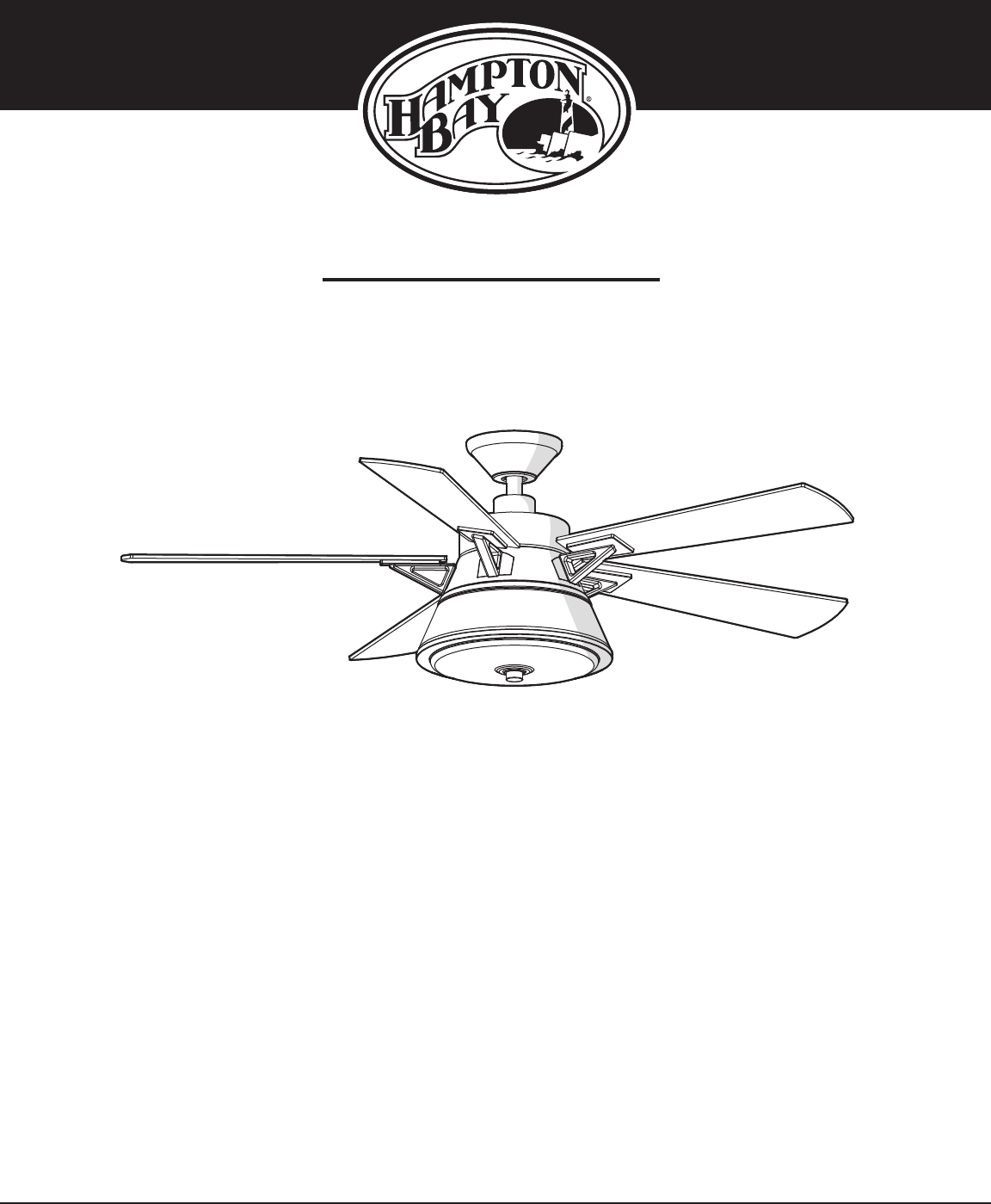
USE AND CARE GUIDE
MARLOWE 52-INCH CEILING FAN
Questions, problems, missing parts? Before returning to the store,
call Hampton Bay Customer Service
8 a.m. - 6 p.m., EST, Monday-Friday.
1-877-527-0313
HAMPTONBAY.COM
THANK YOU
We appreciate the trust and condence you have placed in Hampton Bay through the purchase of this ceiling fan. We strive to continually create
quality products designed to enhance your home. Visit us online to see our full line of products available for your home improvement needs.
Thank you for choosing Hampton Bay!
Item #610-015, 608-891
Model #51398, 51399
UL model #52-MAL
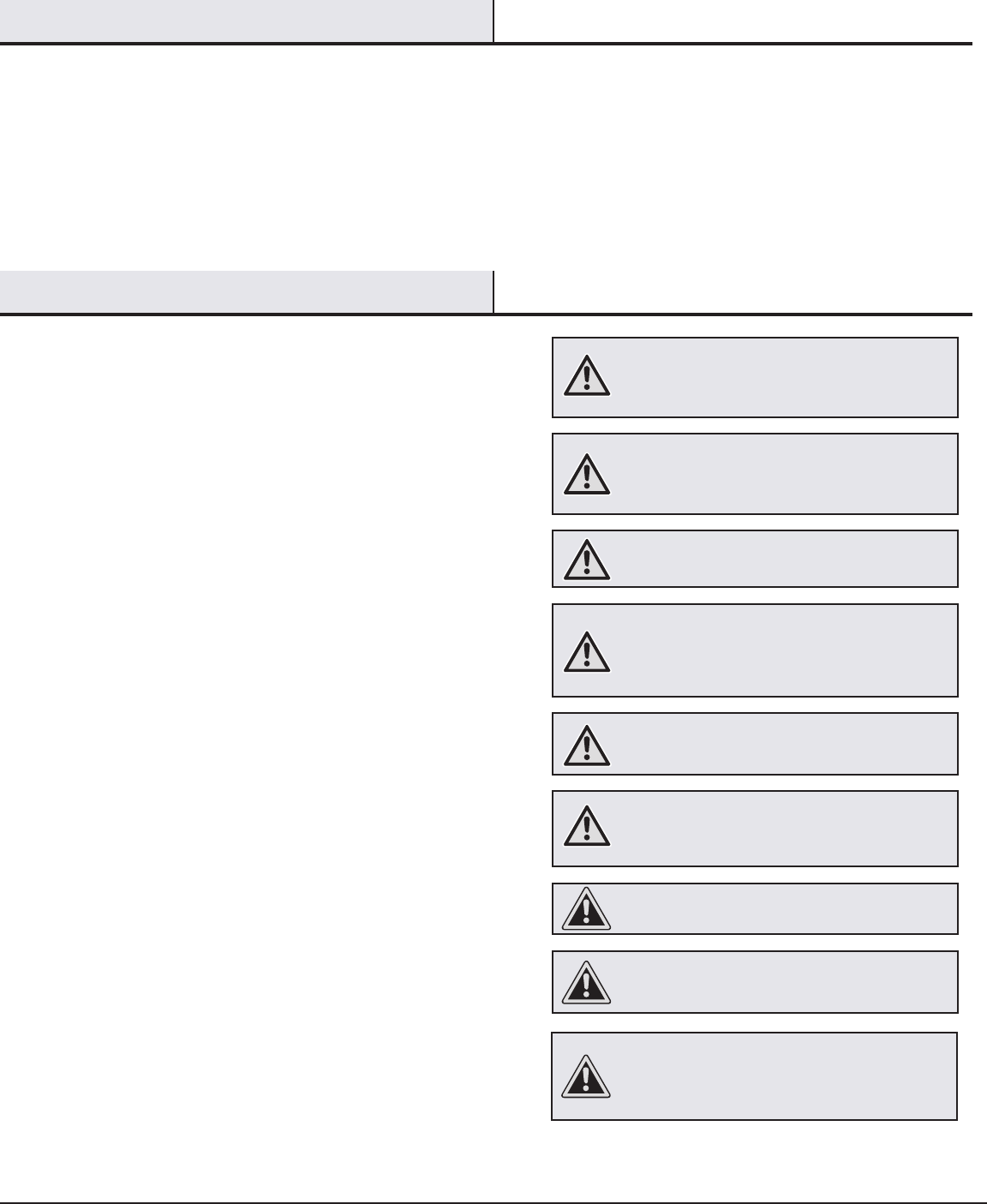
2
Table of Contents ................................................................2
Safety Information ...............................................................2
Warranty ............................................................................... 3
Pre-Installation ....................................................................3
Installation ............................................................................6
Assembly ..............................................................................7
Operation ...........................................................................13
Care and Cleaning ............................................................. 14
Troubleshooting .................................................................14
1. All wiring must be in accordance with the National Electrical
Code ANSI/NFPA 70-1999 and local electrical codes. Electrical
installation should be performed by a qualified licensed
electrician.
2. The outlet box and support structure must be securely mounted
and capable of reliably supporting 35 lbs. (15.9 kg). Use only
UL Listed outlet boxes marked “Acceptable for Fan Support of
35 lbs. (15.9 kg) or less.”
3. The fan must be mounted with a minimum of 7 ft (2 m) clearance
from the trailing edge of the blades to the oor.
4. Do not operate the reversing switch while the fan blades are
in motion. You must turn the fan off and stop the blades before
you reverse the blade direction.
5. Do not place objects in the path of the blades.
6. Electrical diagrams are for reference only. Light kits that are
not packed with the fan must be UL-Listed and marked suitable
for use with the model fan you are installing. Switches must be
UL General Use Switches. Refer to the instructions packaged
with the light kits and switches for proper assembly.
7. After making electrical connections, spliced conductors should
be turned upward and pushed carefully up into the outlet box.
The wires should be spread apart with the grounded conductor
and the equipment-grounding conductor on one side of the
outlet box.
8. All set screws must be checked and retightened where
necessary before installation.
WARNING: To reduce the risk of personal injury, do
not bend the blade brackets (also referred to as
anges) during assembly or after installation. Do not
insert objects in the path of the blades.
WARNING: To reduce the risk of re, electric shock
or personal injury, mount to outlet box marked
“acceptable for fan support of 35lbs. (15.9 Kg) or
less” and use screws provided with the outlet box.
WARNING: To reduce the risk of re or electric
shock, do not use this fan with any solid-state speed
control device.
WARNING: To avoid possible electrical shock, turn
the electricity off at the main fuse box before
wiring. If you feel you do not have enough electrical
wiring knowledge or experience, contact a licensed
electrician.
WARNING: Electrical diagrams are for reference
only. Optional use of any light kit shall be UL-listed
and marked suitable for use with this fan.
WARNING: To reduce the risk of re or electric shock,
this fan should only be used with fan speed control
part no. FAN28R-240W, manufactured by Chia Wei
Electric Co., LTD.
Safety Information
Table of Contents
CAUTION: To reduce the risk of personal injury, use
only the screws provided with the outlet box.
CAUTION: To avoid personal injury or damage to
the fan and other items, use caution when working
around or cleaning the fan.
This device complies with part 15 of the FCC rules, operation is subject to the following two conditions. (1) this device may not cause harmful
interference and (2) this device must accept any interference received, including interference that may cause undesired operation.
CAUTION: Changes or modications not expressly
approved by the party responsible for compliance
could void the user’s authority to operate the
equipment.
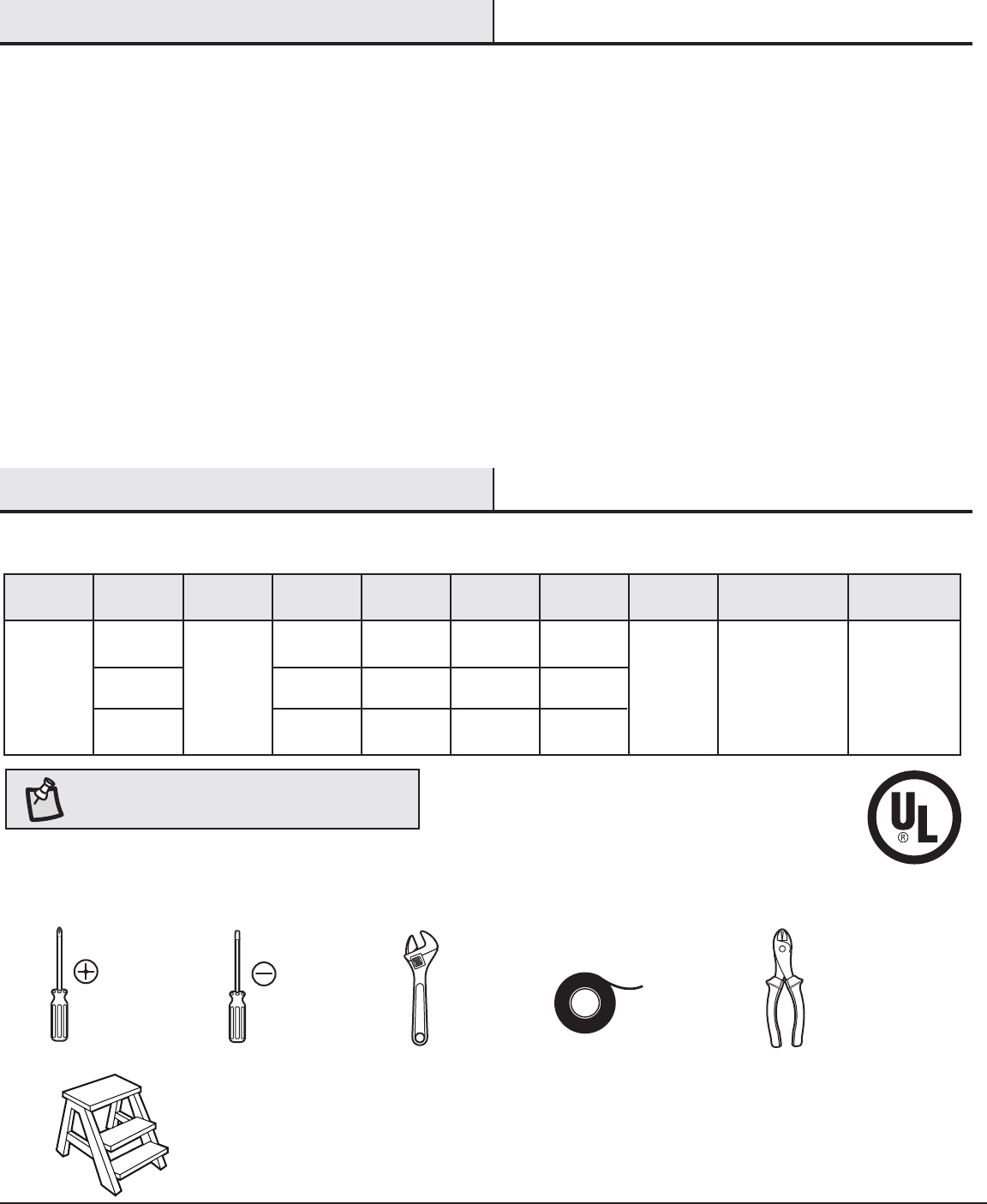
3HAMPTONBAY.COM
Please contact 1-877-527-0313 for further assistance.
Pre-Installation
Warranty
The supplier warrants the fan motor to be free from defects in workmanship and material present at time of shipment from the factory for a life-
time after the date of purchase by the original purchaser. The supplier also warrants that all other fan parts, excluding any glass or acrylic blades,
to be free from defects in workmanship and material at the time of shipment from the factory for a period of one year after the date of purchase
by the original purchaser. We agree to correct such defects without charge or at our option replace with a comparable or superior model if the
product is returned. To obtain warranty service, you must present a copy of the receipt as proof of purchase. All costs of removing and reinstalling
the product are your responsibility. Damage to any part such as by accident or misuse or improper installation or by afxing any accessories, is
not covered by this warranty. Because of varying climatic conditions this warranty does not cover any changes in brass nish, including rusting,
pitting, corroding, tarnishing, or peeling. Brass nishes of this type give their longest useful life when protected from varying weather conditions.
A certain amount of “wobble” is normal and should not be considered a defect. Servicing performed by unauthorized persons shall render the
warranty invalid. There is no other express warranty. Hampton Bay hereby disclaims any and all warranties, including but not limited to those
of merchantability and tness for a particular purpose to the extent permitted by law. The duration of any implied warranty which cannot be
disclaimed is limited to the time period as specied in the express warranty. Some states do not allow a limitation on how long an implied war-
ranty lasts, so the above limitation may not apply to you. The retailer shall not be liable for incidental, consequential, or special damages arising
out of or in connection with product use or performance except as may otherwise be accorded by law. Some states do not allow the exclusion of
incidental or consequential damages, so the above exclusion or limitation may not apply to you. This warranty gives specic legal rights, and you
may also have other rights which vary from state to state. This warranty supersedes all prior warranties. Shipping costs for any return of product
as part of a claim on the warranty must be paid by the customer.
Contact the Customer Service Team at 1-877-527-0313 or visit www.HamptonBay.com.
SPECIFICATIONS
TOOLS REQUIRED
NOTE: These are approximate measures. They do not
include the amps and wattage used by the light kit.
Phillips
screwdriver
Flat blade
screwdriver
Adjustable
wrench
Electrical
tape
Wire
cutter
Step ladder
Size Speed Volts Amps Watts RPM CFM Net
Weight
Gross
Weight Cube Feet
52 in.
Low
Medium
High
120
0.33
0.45
0.56
13.6
30.1
65.2
70
110
165
2613
4030
5924
22.49 lbs.
(10.2 kg)
26.24 lbs.
(11.9 kg) 2.3’
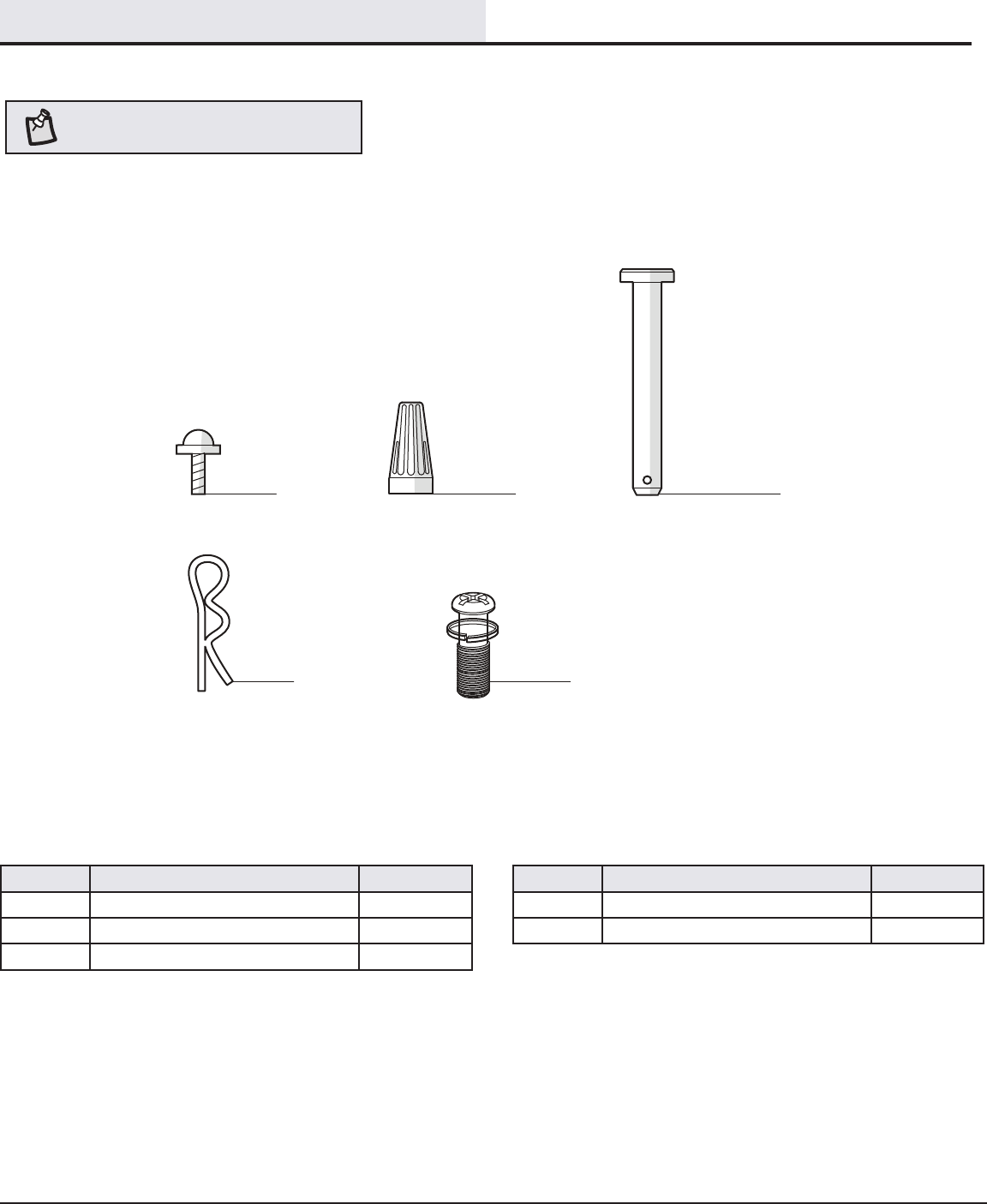
4
Part Description Quantity
AA Blade attachment screws 16
BB Plastic wire connecting nut 3
CC Hanger pin 1
Part Description Quantity
DD Locking pin 1
EE Blade bracket screw with lockwasher 11
Pre-Installation (continued)
HARDWARE INCLUDED
NOTE: Hardware not shown to actual size.
AA BB CC
EE
DD
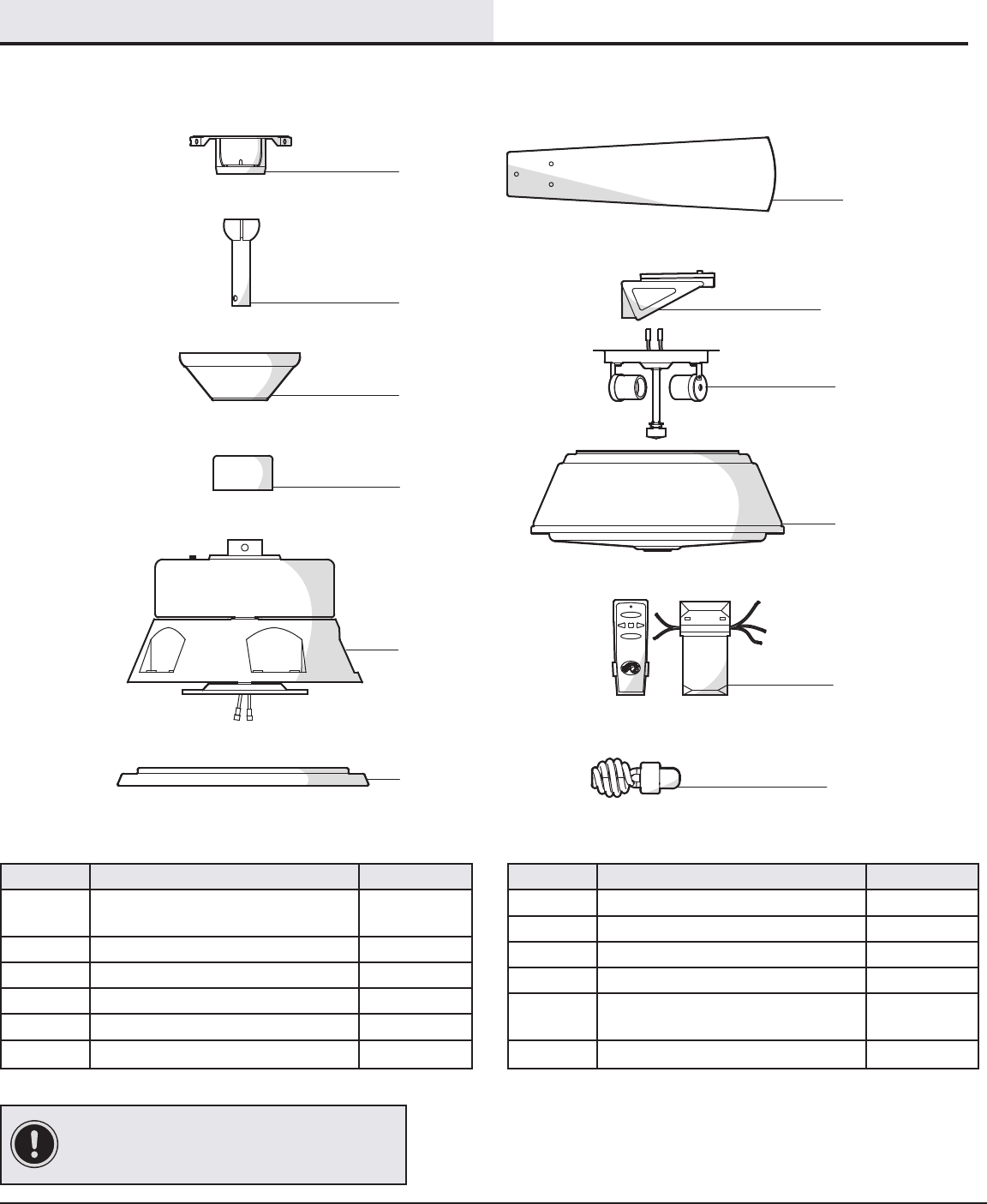
5HAMPTONBAY.COM
Please contact 1-877-527-0313 for further assistance.
Part Description Quantity
ASlide-on mounting bracket
(inside canopy) 1
B Ball/downrod assembly 1
C Canopy with canopy ring attached 1
D Decorative motor collar cover 1
E Fan-motor assembly 1
F Light kit pan 1
Part Description Quantity
G Blade 5
H Blade bracket 5
I Light kit tter assembly 1
J Glass bowl 1
KRemote control/receiver
(batteries included) 1
L CFL light bulb, 14-Watt maximum 2
IMPORTANT: This product and/or components are
governed by one or more of the following U.S. Patents:
5,947,436; 5,988,580; 6,010,110; 6,046,416, 6,210,117
and other patents pending.
Pre-Installation (continued)
PACKAGE CONTENTS
BB
A
B
C
D
E
I
H
F
K
J
G
L
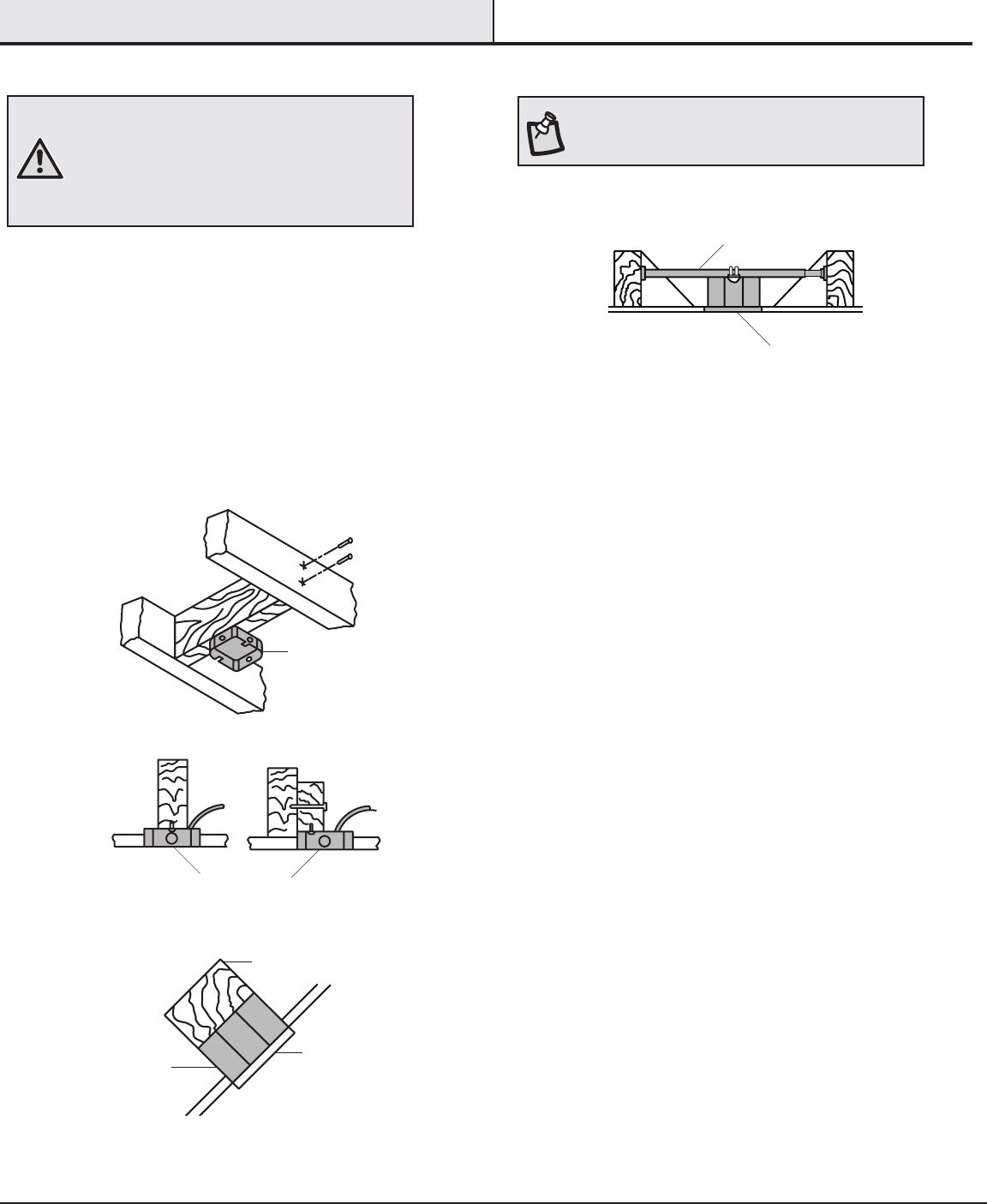
6
Installation
MOUNTING OPTIONS
WARNING: To reduce the risk of re, electric shock
or personal injury, mount to outlet box marked
“acceptable for fan support of 35lbs. (15.9 Kg) or
less” and use screws provided with the outlet box. An
outlet box commonly used for the support of lighting
xtures may not be acceptable for fan support and
may need to be replaced. If in doubt, consult a
qualied electrician.
If your ceiling fan does not have an existing UL-listed mounting
box, then install one using the following instructions:
□Disconnect the power by removing the fuses or turning off
the circuit breakers.
□Secure the outlet box directly to the building structure.
Use the appropriate fasteners and materials. The outlet box
and its bracing must be able to fully support the weight
of the moving fan (at least 35 lbs.). Do not use a plastic
outlet box.
The illustrations below show three different ways to mount the
outlet box.
If the canopy (C) touches the ball/downrod assembly (B), then remove
the decorative canopy bottom cover, and turn the canopy (C) 180°
before attaching the canopy (C) to the mounting plate.
To hang your fan where there is an existing xture but no ceiling joist,
you may need an installation hanger bar as shown above
(available at any Home Depot store).
NOTE: You may need a longer downrod to maintain
proper blade clearance when installing on a steep, sloped
ceiling. The maximum angle allowable is 28° away from
horizontal.
Outlet Box
Outlet Box
Recessed
Outlet
Box
Provide Strong
Support
Ceiling
Mounting
Plate
Outlet Box
Hanger Bar
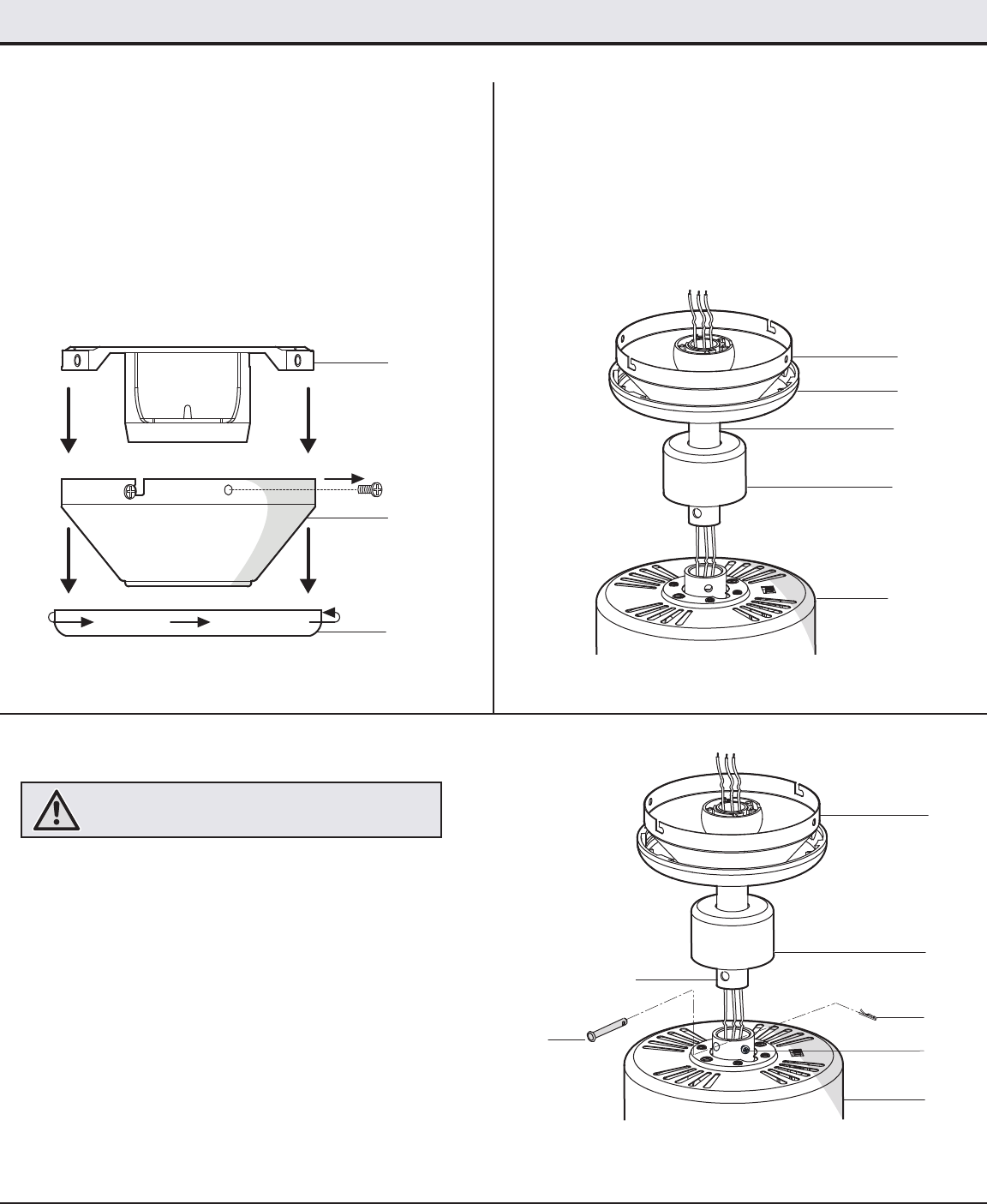
7HAMPTONBAY.COM
Please contact 1-877-527-0313 for further assistance.
Assembly - Standard Ceiling Mount
Routing the wires
Assembling the fan
Preparing for mounting
□Loosen, but do not remove, the setscrew (HH) on the collar on top
of the fan-motor assembly (E).
□Align the holes at the bottom of the ball/downrod assembly (B)
with the holes in the collar on top of the fan-motor assembly (E).
□Carefully insert the hanger pin (CC) through the holes in the collar
and ball/downrod assembly (B). Be careful not to jam the hanger
pin (CC) against the wiring inside the ball/downrod assembly (B).
□Insert the locking pin (DD) through the hole near the end of the
hanger pin (CC) until it snaps into its locked position.
□Re-tighten the setscrew (HH) on the collar on top of the fan-
motor assembly (E).
□Remove the canopy ring (O) from the canopy (C) by turning
the ring to the right until it unlocks.
□Remove the mounting bracket (A) from the canopy (C) by
loosening the four screws on the top of the canopy (C).
□Remove the two non-slotted screws, and loosen the slotted
screws. This will enable you to remove the mounting bracket
(A).
□Route the wires exiting the top of the fan motor (E) into
the decorative motor collar cover (D) and through the
canopy ring (O).
□Make sure the slot openings are on top and route the
wires through the canopy (C) and then through the ball/
downrod assembly (B).
2
3
1
C
A
O
E
D
C
B
O
B
CC
DD
D
E
C
B
HH
WARNING: Failure to properly install the locking pin could
result in the fan becoming loose and possibly falling.
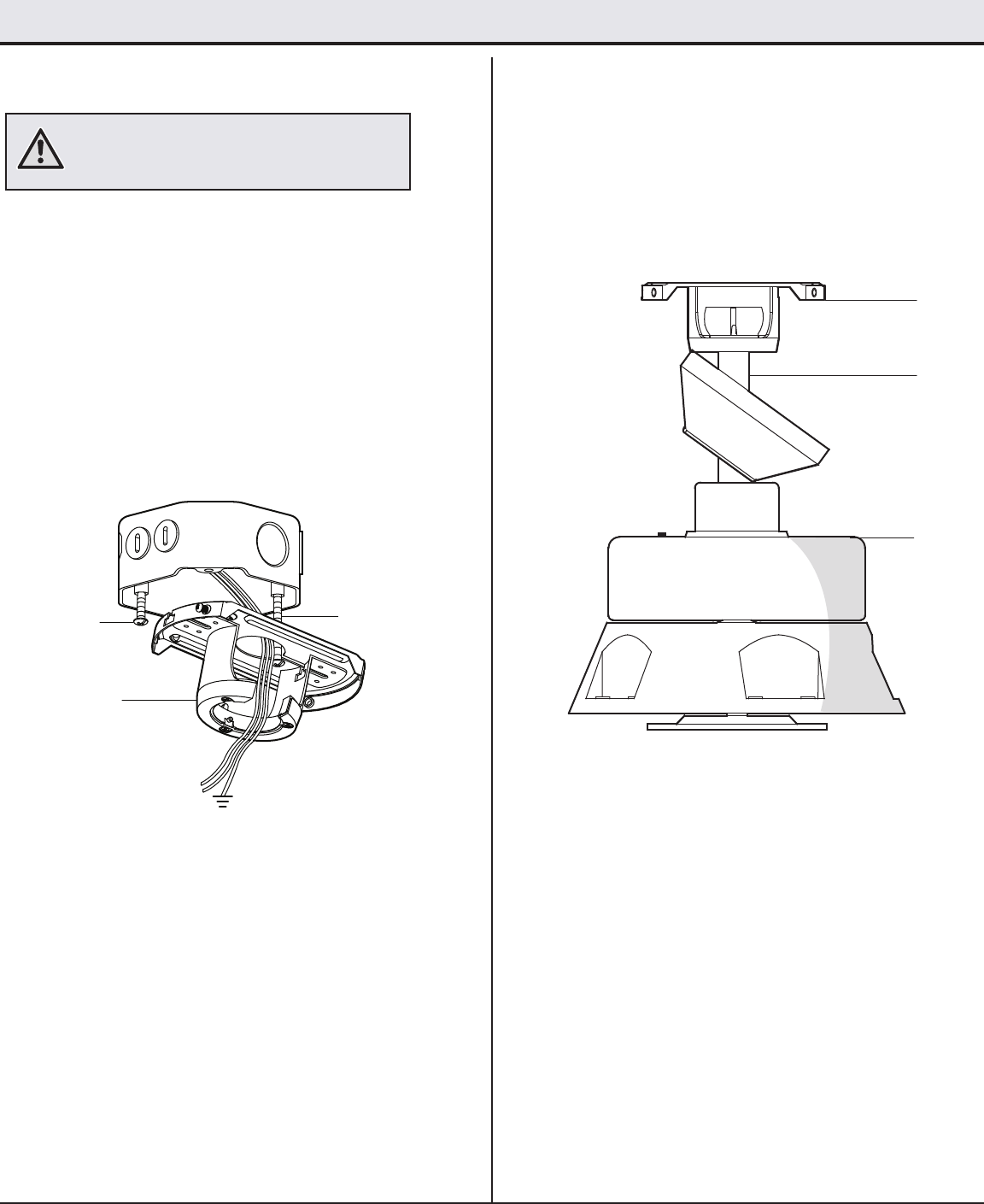
8
Assembly - Hanging the Fan
Attaching the fan to the electrical
box Hanging the fan
□Pass the 120-Volt supply wires through the center hole in the
slide-on mounting bracket (A).
□Install the ceiling mounting bracket on the outlet box by slid-
ing the slide-on mounting bracket (A) over the two screws (UU)
provided with the outlet box. If necessary, use leveling washers
(not included) between the slide-on mounting bracket (A) and the
outlet box. Note that the at side of the mounting bracket (A) is
toward the outlet box.
□Securely tighten the two mounting screws (UU).
□Carefully lift the fan-motor assembly (E) up to the slide-on
mounting bracket (A).
□Seat the hanger ball portion of the ball/downrod assembly (B)
in the mounting bracket socket. Ensure that the tab on the
slide-on mounting bracket (A) socket is properly seated in the
groove in the hanger ball.
4 5
WARNING: To reduce the risk of re, electric shock
or personal injury, mount to outlet box marked
“acceptable for fan support of 35lbs. (15.9 Kg) or
less” and use screws provided with the outlet box.
A
UU UU
A
B
E
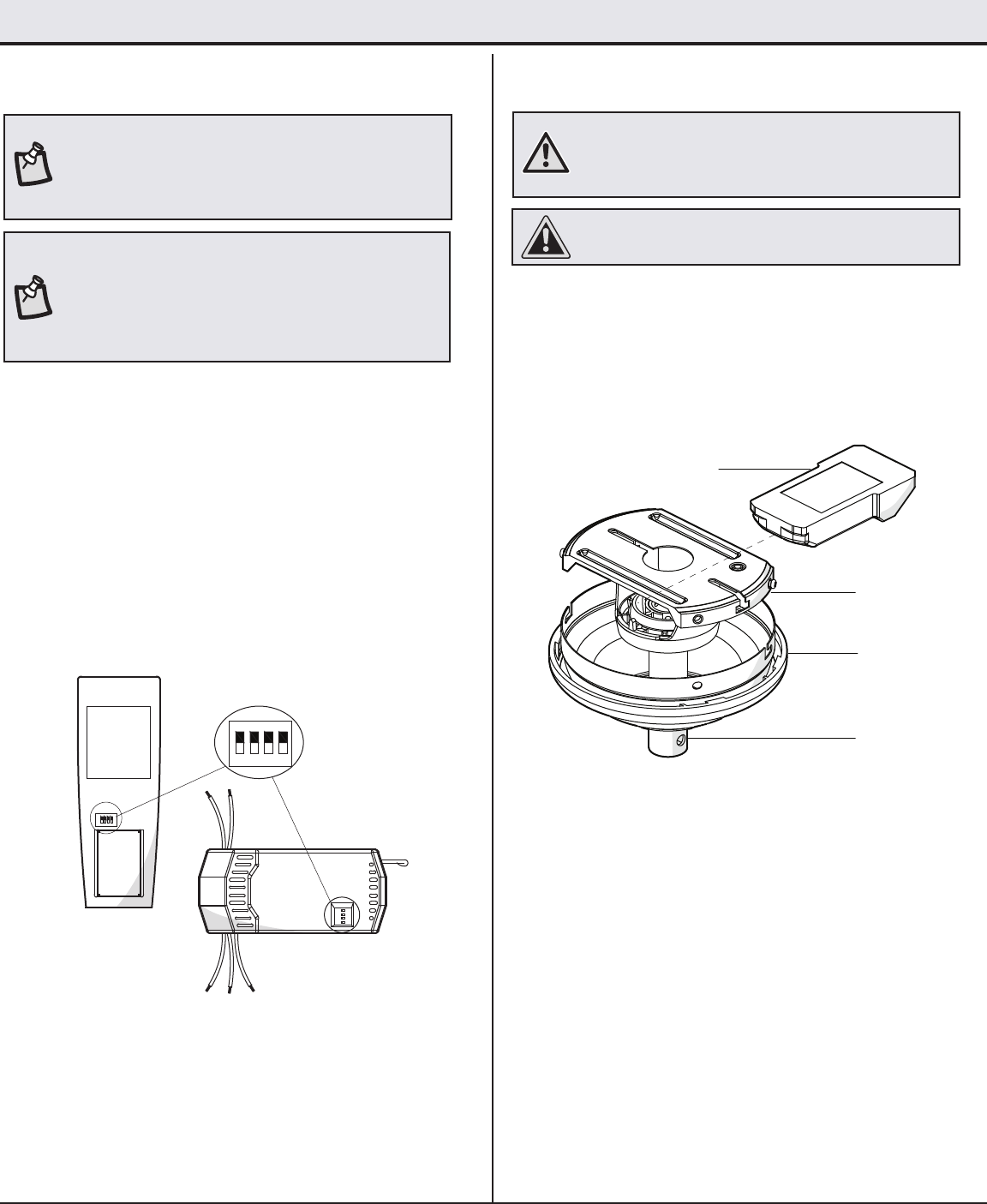
9HAMPTONBAY.COM
Please contact 1-877-527-0313 for further assistance.
Assembly - Hanging the Fan (continued)
1 2 3
ON
4
1 2 3
ON
4
DIP
Setting the remote control codes
6
NOTE: The frequencies on your receiver and remote control have
been preset at the factory. Before installing the receiver, make
sure the dip switches on the receiver and remote control are set
to the same frequency. The dip switches on the remote control
are located inside the battery compartment.
To set the code on the remote control:
□Remove the battery cover by pressing rmly on the arrow
and sliding the cover off.
□Slide the code switches to your choice of either up or down.
The factory setting is up.
□Install a 9-V battery (included) into the remote control.
□Replace the battery cover on the remote control.
To set the code on the receiver:
□Slide the code switches to the same position as set on your
remote control.
Controller Model: FAN28R-240W
NOTE: This remote is equipped with a 16-code combination.
To prevent possible interference from or to other remote units,
such as garage door openers, car alarms, or security systems,
change the combination code, but be sure that the code on
both the hand held transmitter and receiver in the fan are the
same.
Installing the receiver
□Position the remote control/receiver (K) at side up and per-
pendicular to the slide-on mounting bracket (A).
□Position the supply wires to the left side of the slide-on mount-
ing bracket (A), and position the fan wires to the right side.
□Partially insert the remote control/receiver (K) at side up until
one end rests on the ball/downrod assembly (B).
7
WARNING: To reduce the risk of re or electric shock,
remember to disconnect power. The electrical wiring must
meet all local and national electrical code requirements. The
electrical source and fan must be 110/120 volt, 60Hz.
CAUTION: If other fan wires are a different color, have this unit
installed by a licensed electrician.
A
B
K
C
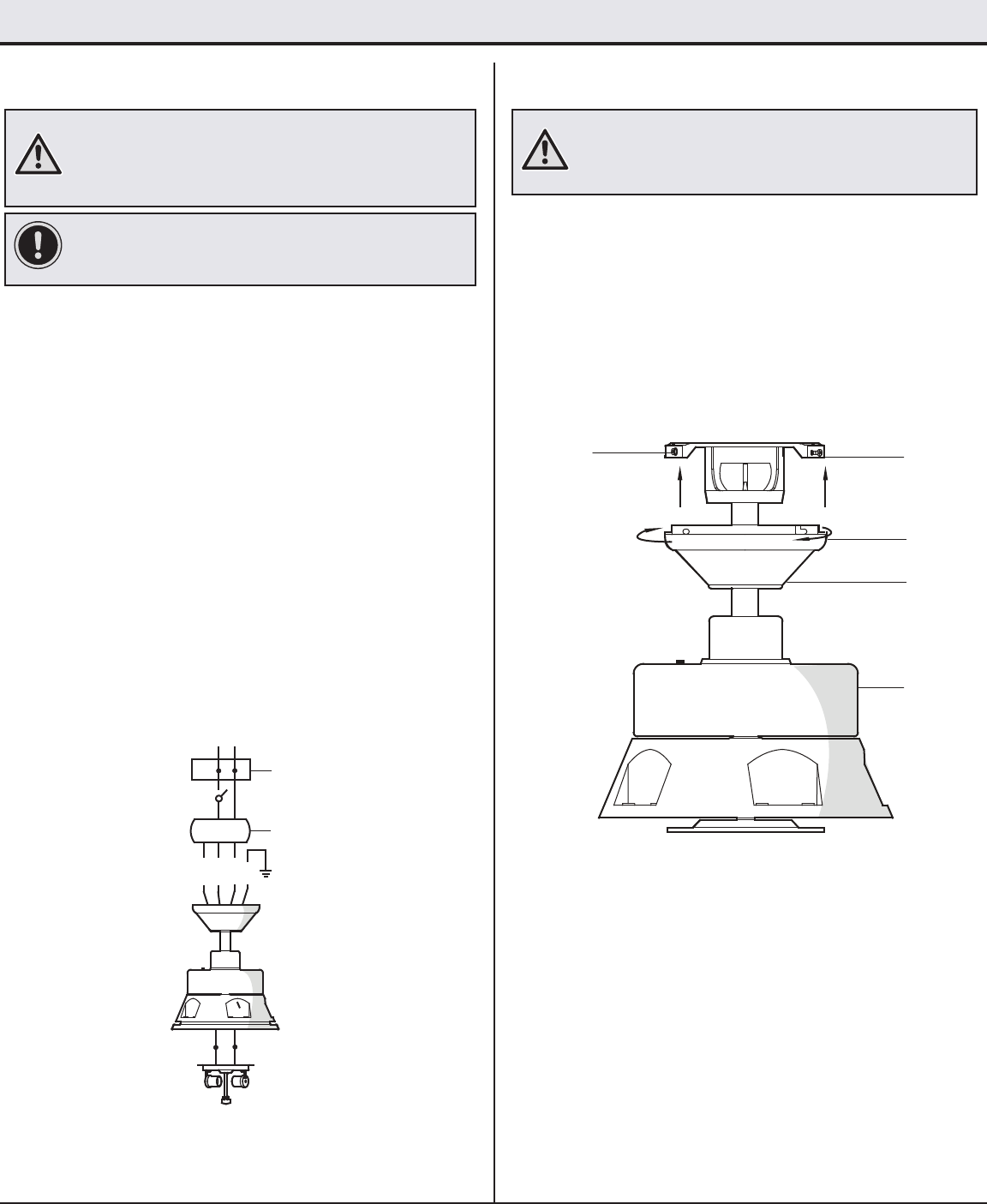
10
Mounting the fan
□Align the locking slots of the canopy (C) with the two screws
in the slide-on mounting bracket (A). Push up to engage the
slots, and turn clockwise to lock the canopy (C) in place.
□Firmly tighten the two mounting screws (M).
□Install the remaining two mounting screws (M) into the holes
in the canopy (C) and tighten rmly.
□Install the canopy ring (O) by aligning the ring’s slots with the
screws in the canopy (C). Rotate the ring counter-clock-
wise to lock it in place.
9
WARNING: When using the standard ball/downrod mounting, the
tab in the ring at the bottom of the mounting bracket must rest in
the groove of the hanger ball. Failure to properly seat the tab in
the groove could cause damage to the wiring.
LL
LL
KK
JJ
II
MM
NN
OO
LL
LL
KK
JJ
KK
LL
A
C
M
E
O
Assembly - Hanging the Fan (continued)
Making the electrical connection
□Connect the ground conductor of the 120-Volt supply (this
may be a bare wire or a wire with green colored insulation) to
the green ground lead(s) (II) of the fan using a wire connecting
nut (BB).
□Connect the fan motor white wire (LL) to the receiver (NN) white
wire (LL) using a plastic wire connecting nut (BB).
□Connect the fan motor black wire (KK) to the receiver (NN)
black wire (KK) using a plastic wire connecting nut (BB).
□Connect the fan motor blue wire (JJ) to the receiver (NN) blue
wire (JJ) using a plastic wire connecting nut (BB).
□Connect the receiver (NN) red wire (OO) to the supply black
(hot) wire (KK) using a plastic wire connecting nut (BB).
□Connect the receiver (NN) white wire (LL) to the supply white
wire (neutral) (LL) wire using a plastic wire connecting nut (BB).
□After connecting the wires, spread them apart so that the
green (II) and white (LL) wires are one side of the outlet box
(MM) and the black wire (KK) is on the other side.
□Turn the plastic wire connecting nuts upward, and carefully
push the wiring into the outlet box (MM).
8
IMPORTANT: Use the plastic wire connecting nuts (BB) supplied with
your fan and remote control. Secure the connectors with electrical
tape and ensure there are no loose strands or connections.
WARNING: Each wire nut supplied with this fan is designed to
accept up to one 12-gauge house wire and two wires from the
fan. If you have larger than 12-gauge house wiring or more than
one house wire to connect to the fan wiring, consult an electrician
for the proper size wire nuts to use.
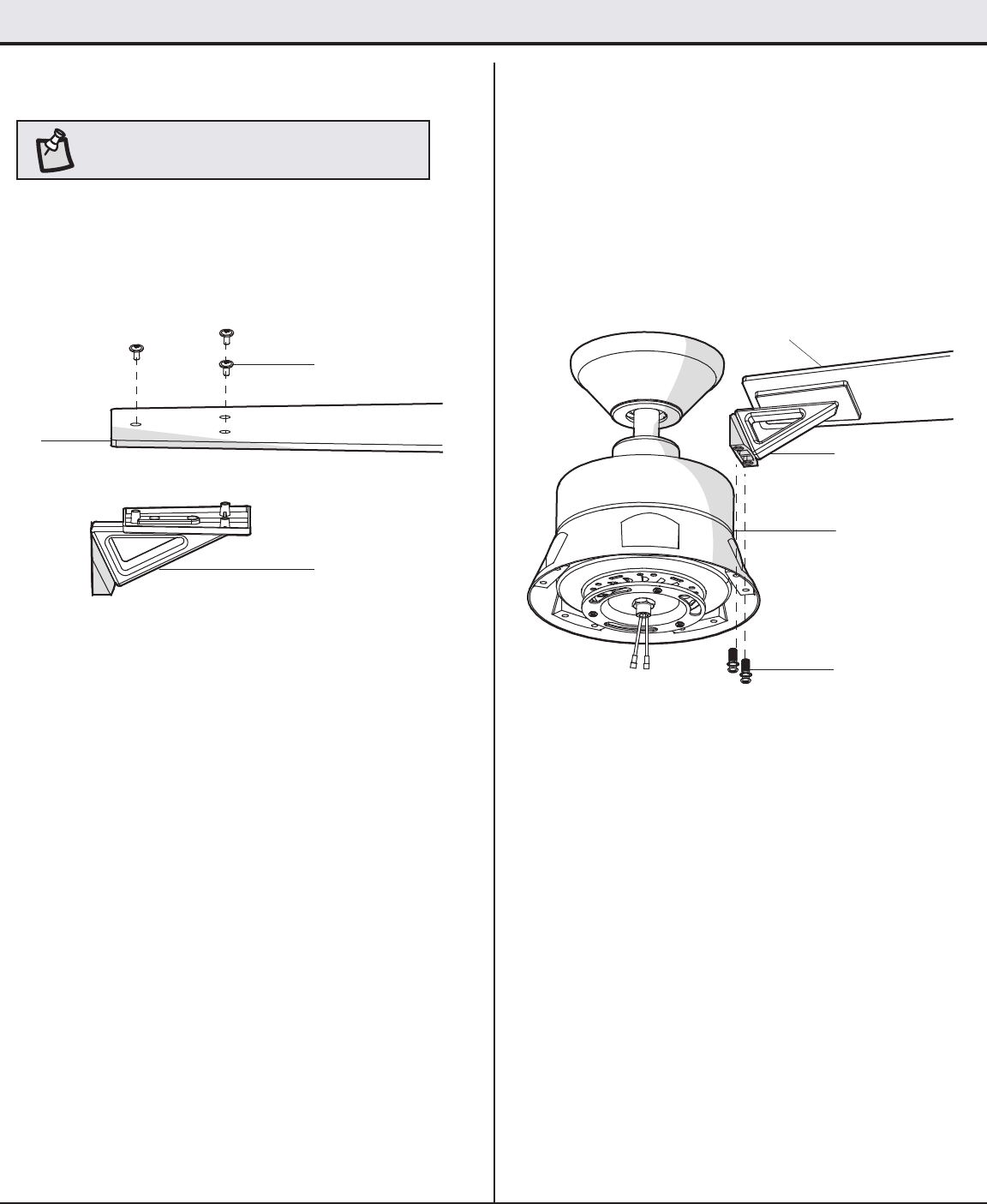
11 HAMPTONBAY.COM
Please contact 1-877-527-0313 for further assistance.
Assembly - Attaching the Fan Blades
Attaching the fan blades Attaching the blade assemblies
10 11
□Attach the blade (G) to the blade bracket (H) using the blade
attachment screws (AA). Start a blade attachment screw
(AA) into the blade bracket (H). Repeat for the two remaining
blade attachment screws (AA).
□Tighten each blade attachment screw (AA) securely.
□Attach the blade assembly to the fan-motor assembly (E)
by aligning the two holes of blade bracket (H) with the two
holes of the fan-motor assembly (E).
□Insert a blade bracket screw with lockwasher (EE) into the
blade bracket (H). Repeat for the one remaining screw.
□Tighten each blade bracket screw with lockwasher (EE)
securely.
□Repeat these steps for the remaining blades (G).
AA
G
H
H
G
E
EE
NOTE: Your fan blades are reversible. Select the blade
side nish which best accentuates your decor.
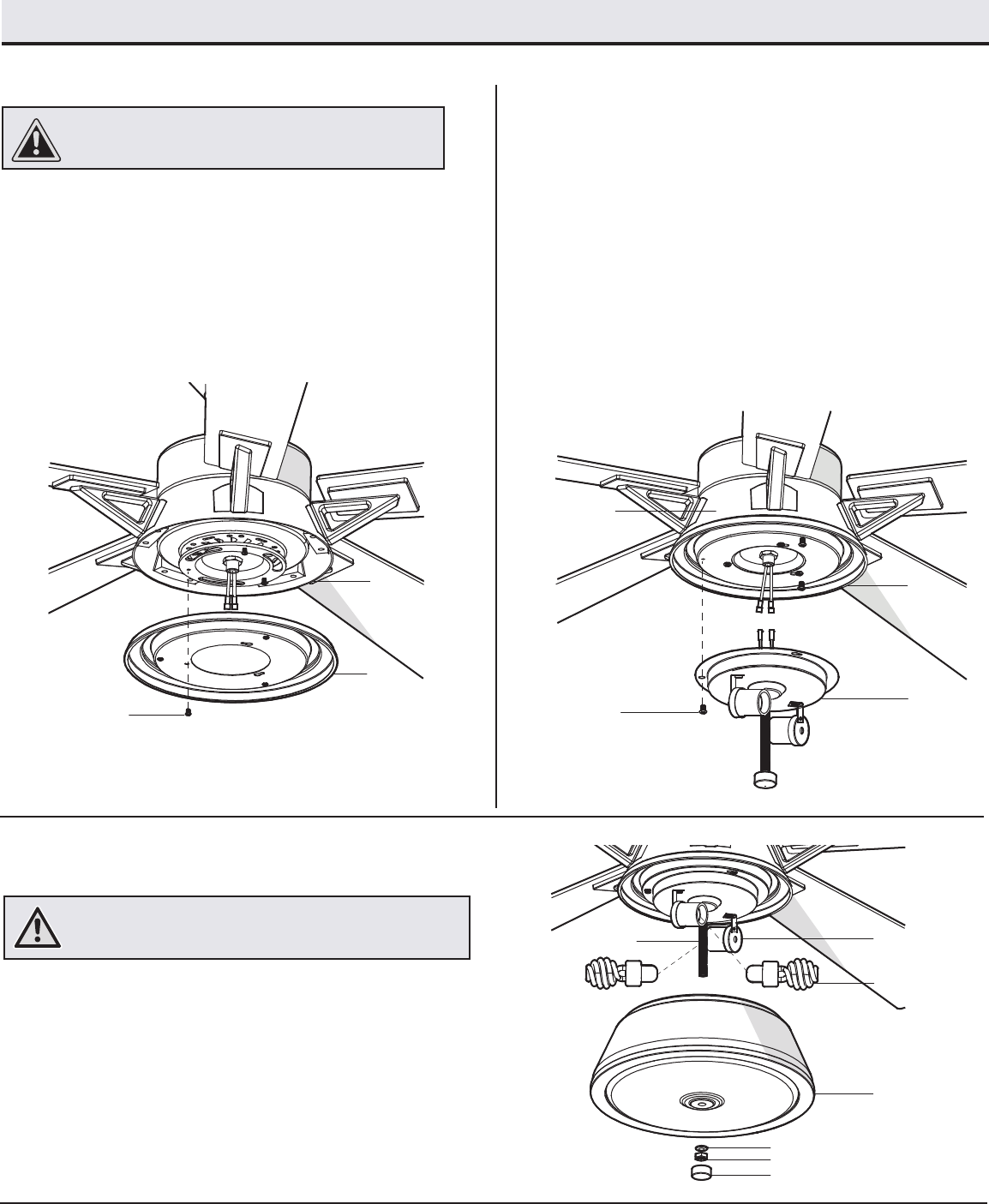
12
Assembly - Attaching the Light Kit
Attaching the light kit pan Attaching the light kit
Installing the light bulbs and
glass bowl
12 13
14
□Remove one screw (N) from the black bracket below the
fan-motor assembly (E). Loosen, but do not remove the
other two screws.
□Attach the light kit pan (F) to the fan-motor assembly (E)
by securing them with the two screws (N) loosened in the
rst step. Push the light kit pan (F) up to engage the screw
heads in the screw slots and turn to secure. Re-install the
screw (N) removed in the rst step. Tighten each screw
rmly.
□Remove one screw (P) from the light kit pan (F). Loosen, but
do not remove the other two screws.
□Connect the blue wire exiting the bottom of the fan-motor
assembly (E) with the black wire from the top of the light kit
tter assembly (I).
□Connect the white wire exiting the bottom of the fan-motor
assembly (E) with the white wire from the top of the light kit
tter assembly (I).
□Attach the light kit tter (I) to the light kit pan (F) by securing
them with the two screws (P) loosened in the rst step. Push
the light kit tter assembly (I) up to engage the screw heads
in the screw slots and turn to secure. Re-install the screw (P)
removed in the rst step. Tighten each screw rmly.
□With the power off, install the light bulbs (L) (Max. 14W,
provided) into the light bulb sockets.
□Remove the nial (PP), hex nut (QQ), and rubber washer (RR)
from the threaded nipple (SS) of light kit tter assembly (I).
Place the threaded nipple through the centre hole of the glass
bowl (J). Re-install the rubber washer (RR), hex nut (QQ), and
nial (PP).
CAUTION: To reduce the risk of electric shock, disconnect
the electrical supply circuit to the fan before installing the
light kit.
WARNING: Do not overtighten when installing the glass shade
into the light kit assembly. Allow the glass shade to cool
completely before removing.
E
F
N
F
I
P
E
J
PP
QQ
RR
SS
L
I
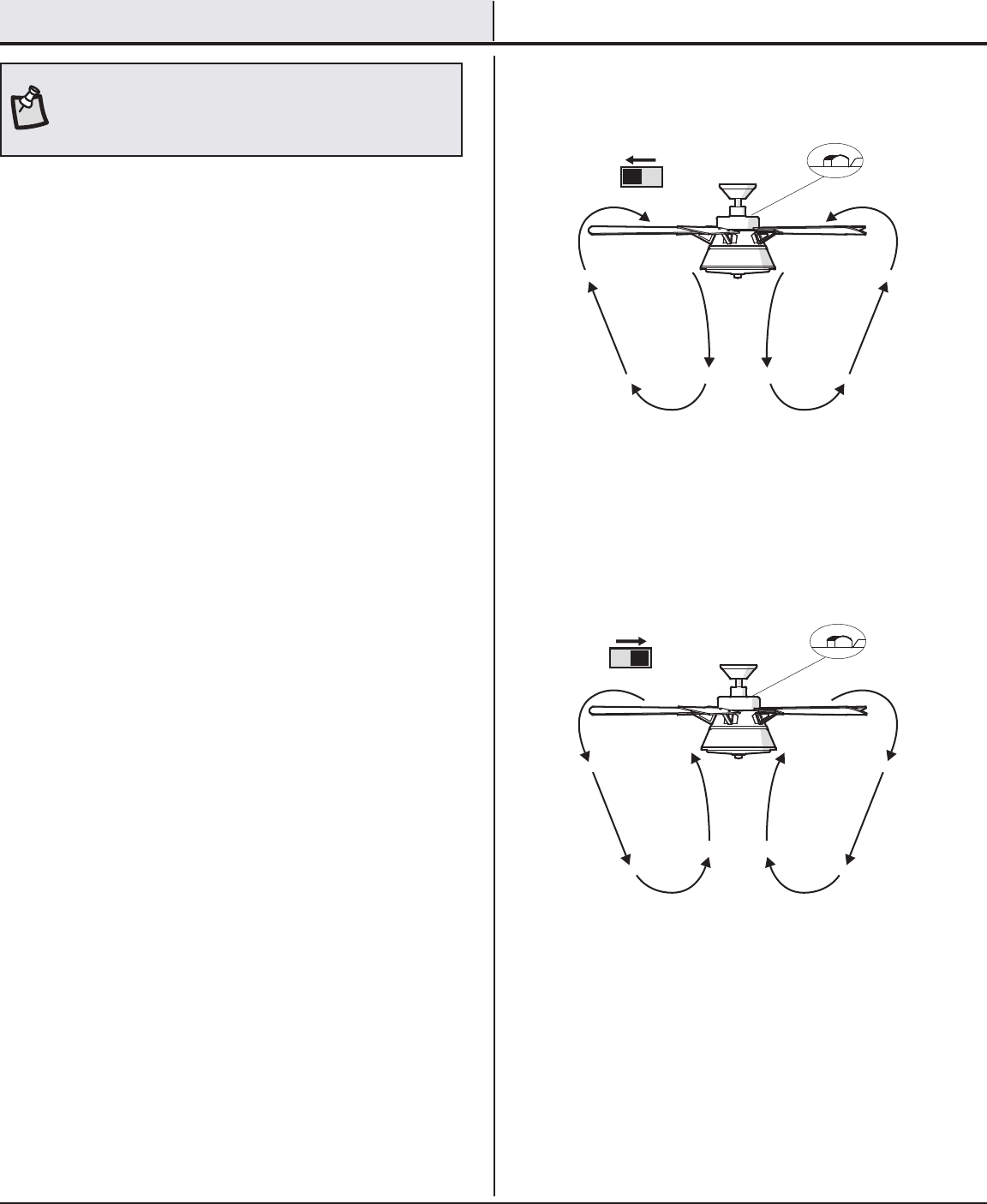
13 HAMPTONBAY.COM
Please contact 1-877-527-0313 for further assistance.
Operation
Remote Control - Your fan is equipped with a remote control to
operate the speed and lights of your new ceiling fan.
The appropriate speed settings for warm or cool weather depend
on factors such as the room size, ceiling height, and number of
fans.
The fan is shipped from the factory with the reversing switch
positioned to circulate air downward. If airow is desired in the
opposite direction, turn your fan off and wait for the blades to stop
turning. Slide the reversing switch (located at the top of the motor
housing) to the opposite position, and turn the fan on again. The fan
blades will turn in the opposite direction and reverse the airow.
1. Speed - The remote features Low, Med, Hi and Off buttons to select
the desired speed of operation and turn the fan On or Off.
2. Light - To control the light kit, the remote features a Light On/Off
button.
Operating the fan
High button = High speed
Medium button = Medium speed
Low button = Low speed
Off button = Power off
Light On/Off= Turn light on or off
Cool weather - (Reverse) An upward airow moves warm air off of
the ceiling. This allows you to set your heating unit on a cooler set-
ting without affecting your comfort.
Warm weather - (Forward) A downward airow creates a cooling ef-
fect. This allows you to set your air conditioner on a warmer setting
without affecting your comfort.
NOTE: The reverse switch is located at the top of motor housing.
Shut the fan off and wait until the blades have completely stopped
before ipping the switch to reverse the direction of your ceiling
fan.
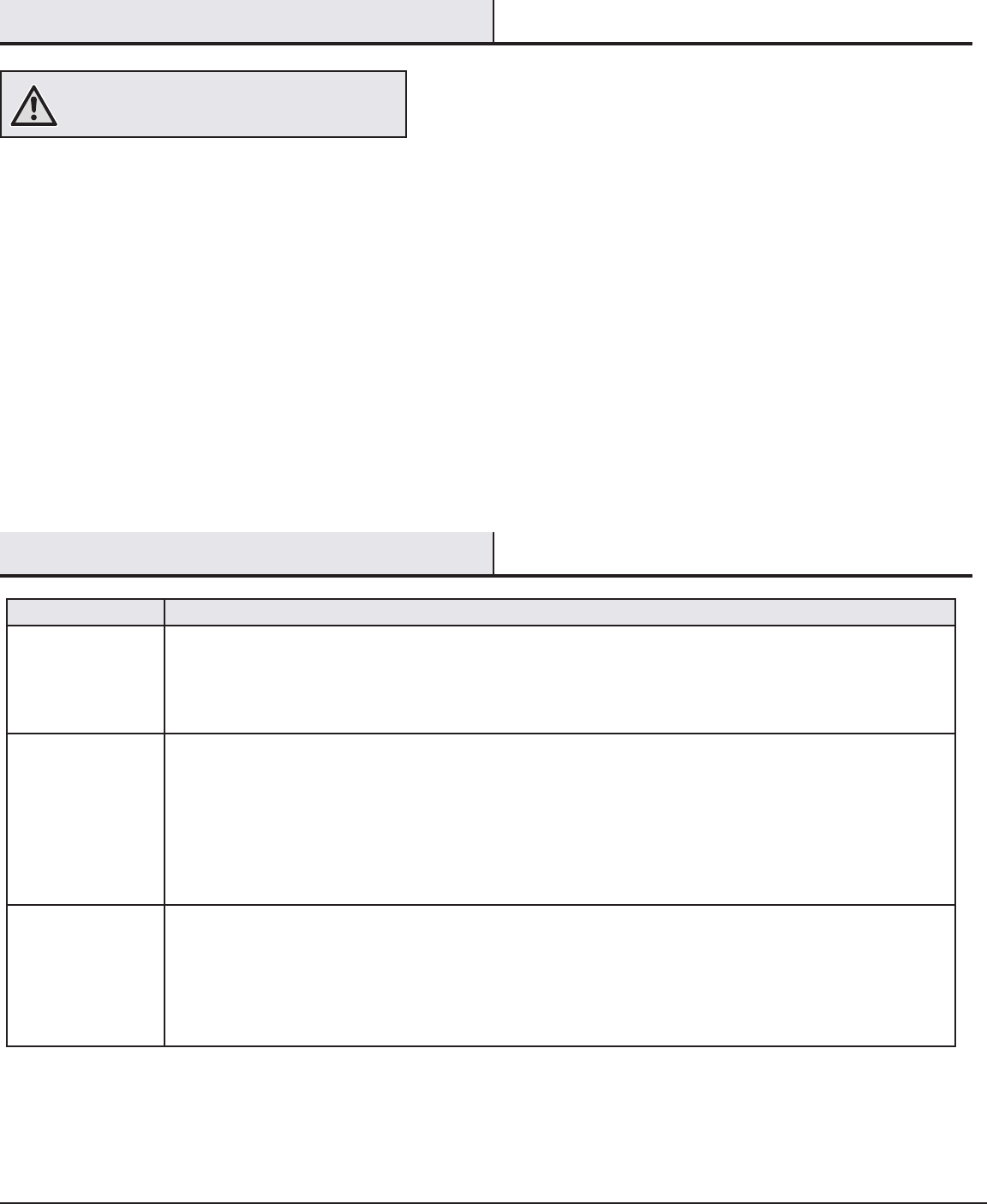
14
Troubleshooting
Problem Solution
The fan will not start. □Check the main and branch circuit fuses or breakers.
□Check the line wire connections to the fan and switch wire connections in the switch housing.
□Check the battery in the remote control.
□Ensure you are in the normal range of 10-20 feet.
□Turn the power off and ensure that the dip switch settings are the same on the remote control and receiver.
The fan is noisy. □Ensure all motor housing screws are snug.
□Ensure the screws that attach the fan blade bracket to the motor hub are tight.
□Ensure the wire nut connections are not rattling against each other or the interior wall of the switch housing.
□Allow a 24-hour “breaking in” period. Most noises associated with a new fan disappear during this time.
□If you are using the ceiling fan light kit, ensure the screws securing the glassware are tight. Check that the light
bulbs are also secure.
□Ensure the canopy is a short distance from the ceiling. It should not touch the ceiling.
□Ensure your outlet box is secure and rubber isolator pads were used between the mounting plate and outlet box.
The fan wobbles. □Check that all blade and blade arm screws are secure.
□Most fan wobble problems are caused when blade levels are unequal. Check this level by selecting a point on the
ceiling above the tip of one of the blades. Measure from a point on the center of each blade to the point on the
ceiling. Measure this distance. Rotate the fan until the next blade is positioned for measurement. Repeat for each
blade. Any measurement deviation should be within 1/8 in. Run the fan for ten minutes. If the fan continues to
wobble please contact Customer Service and a balacing kit will be sent to you at no charge.
□Because of the fan’s natural movement, some connections may become loose. Check the support connections, brackets, and blade
attachments twice a year. Make sure they are secure. It is not necessary to remove the fan from the ceiling.
□Clean your fan periodically to help maintain its new appearance over the years. Do not use water when cleaning, as this could damage
the motor, or the wood, or possibly cause an electrical shock. Use only a soft brush or lint-free cloth to avoid scratching the nish. The
plating is sealed with a lacquer to minimize discoloration or tarnishing.
□You can apply a light coat of furniture polish to the wood for additional protection and enhanced beauty. Cover small scratches with a
light application of shoe polish.
□You do not need to oil your fan. The motor has permanently-lubricated sealed ball bearings.
WARNING: Make sure the power is off before cleaning
your fan.
Care and Cleaning

Questions, problems, missing parts? Before returning to the store,
call Hampton Bay Customer Service
8 a.m. - 6 p.m., EST, Monday-Friday
1-877-527-0313
HAMPTONBAY.COM
Retain this manual for future use.
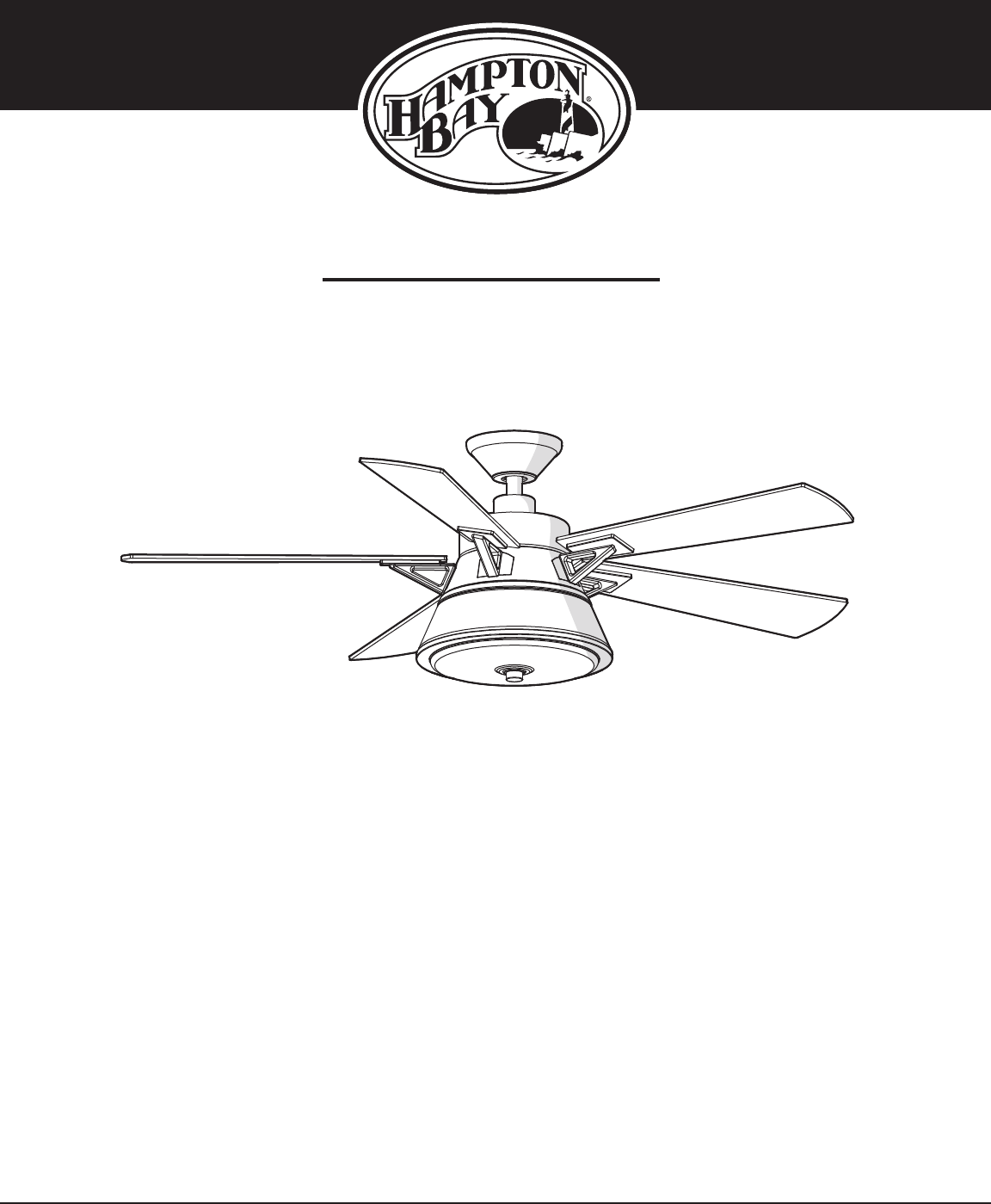
GUÍA DE USO Y MANTENIMIENTO
VENTILADOR DE TECHO MARLOWE, DE 52 PLG (1,32 M)
¿Preguntas, problemas o piezas faltantes? Antes de regresar a la tienda,
llama al Servicio al Cliente de Hampton Bay
de Lunes a Viernes entre 8 a.m. y 6 p.m., (Hora del Este de EE. UU.)
1-877-527-0313
HAMPTONBAY.COM
GRACIAS POR TU COMPRA
Apreciamos la conanza que has depositado en Hampton Bay al comprar este ventilador de techo. Nos esforzamos para continuamente crear
productos de calidad diseñados para tu hogar. Visítanos por Internet para ver nuestra línea completa de productos disponibles para las necesidades
de mejoras de tu hogar. ¡Gracias por elegir Hampton Bay!
Artículo Núm. 610-015, 608-891
Modelo Núm. 51398, 51399
Modelo Núm. 52-MAL Aprobado
por UL
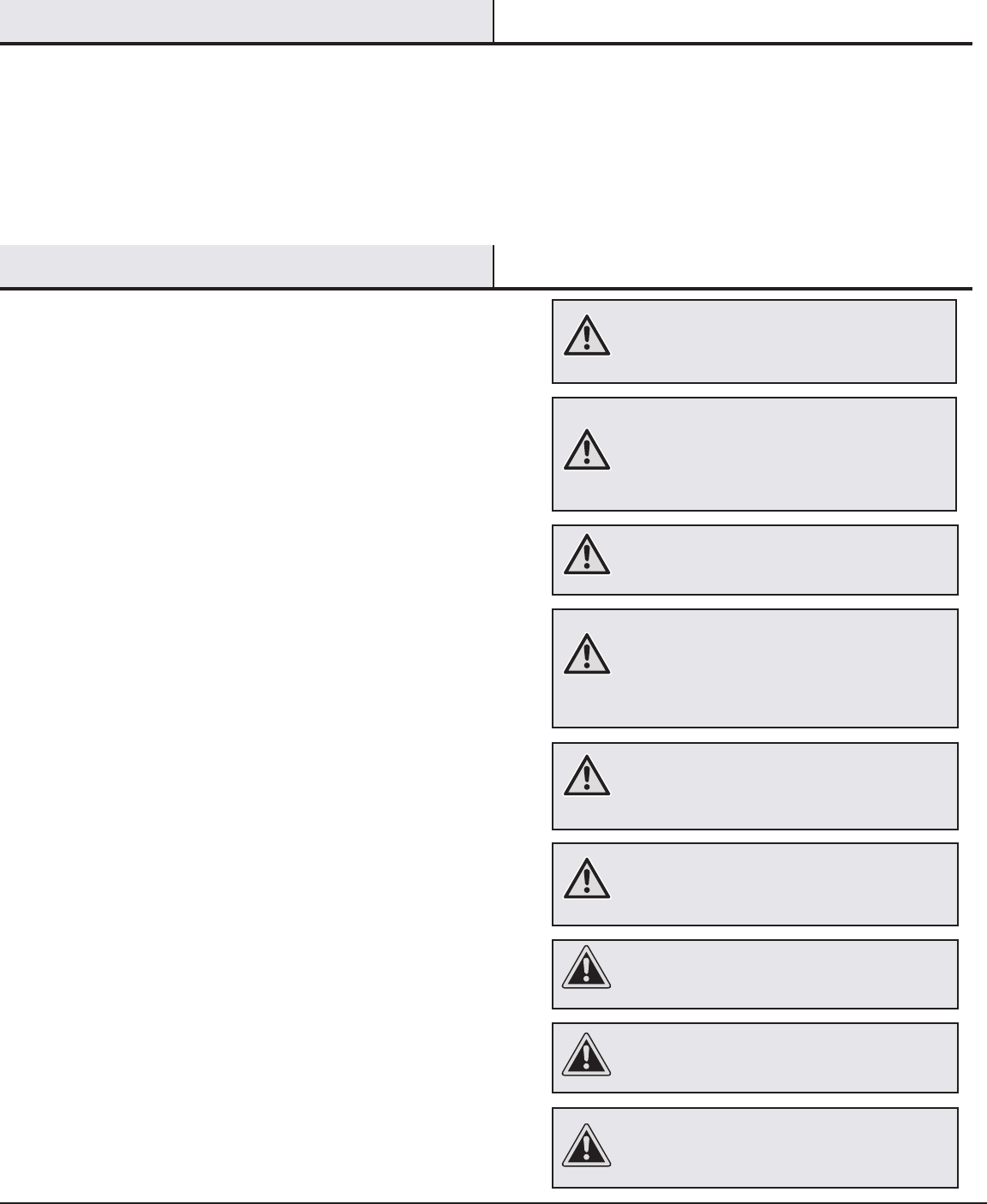
2
Tabla de Contenido .............................................................2
Información de Seguridad ..................................................2
Garantía ................................................................................3
Preinstalación ......................................................................3
Instalación ............................................................................6
Ensamblaje ...........................................................................7
Funcionamiento .................................................................13
Mantenimiento y Limpieza................................................14
Solución de Problemas ..................................................... 14
1. Todo el cableado debe cumplir con el Código Nacional
de Electricidad ANSI/NFPA 70-1999 y con los códigos locales
de electricidad. La instalación eléctrica debe ser hecha por un
electricista certicado y calicado.
2. La caja eléctrica y estructura de soporte deben montarse de
forma segura y tener capacidad para sostener de manera
conable 35 lb. Usa solamente cajas eléctricas aprobadas por
UL marcadas como “Aprobada como soporte de ventiladores de
35 lb (15,9 kg) o menos.”
3. El ventilador debe ir montado con un mínimo de 7 pies (2 m)
de separación entre el borde trasero de las aspas y el piso.
4. No muevas el interruptor de reversa mientras las aspas del
ventilador estén en movimiento. Debes apagar y detener las
aspas antes de invertir la dirección de las aspas.
5. No coloques objetos en la trayectoria de las aspas.
6. Los diagramas eléctricos son sólo para referencia.
Los kits de luces no empaquetados con el ventilador deben
estar aprobados por UL y marcados como apropiados para ser
usados con el modelo de ventilador a instalar. Los interruptores
deberán estar clasicados por el UL como de uso general.
Consulta las instrucciones adjuntas a los kits de luces e
interruptores para obtener información sobre el ensamblaje
adecuado.
7. Después de concluir con las conexiones eléctricas, debes
voltear los conductores empalmados hacia arriba y empujarlos
con cuidado dentro de la caja eléctrica. Los cables deben
estar separados con el cable a tierra y el conductor a tierra del
equipo, hacia uno de los lados de la caja eléctrica.
8. Todos los tornillos de jación se deben vericar
y ajustar donde sea necesario antes de la instalación.
ADVERTENCIA: Para reducir el riesgo de lesiones
personales, no dobles los soportes de las aspas (también
llamados “bridas”) durante o después de la instalación.
No coloques objetos en la trayectoria de las aspas.
ADVERTENCIA: Para reducir el riesgo de incendio,
descarga eléctrica o lesiones personales, monta el
ventilador sobre una caja eléctrica marcada como
“aprobada como soporte de ventiladores de 35 lb (15,9
kg) o menos”, y usa los tornillos de montaje que vienen
con la misma.
ADVERTENCIA: Para reducir el riesgo de incendio o
descarga eléctrica, no utilices este ventilador con ningún
dispositivo de control de velocidad de estado sólido.
ADVERTENCIA: Para evitar una posible descarga
eléctrica, desconecta la electricidad de la caja de
fusibles principal antes de realizar el cableado.
Si crees que no tienes suciente conocimiento o
experiencia sobre cableado eléctrico, contacta a un
electricista certicado.
ADVERTENCIA: Los diagramas eléctricos son sólo para
referencia. Cualquier kit de luces opcional debe estar
aprobado por UL y estar marcado como adecuado
para ser usado con este ventilador.
ADVERTENCIA: Para disminuir el riesgo de incendio o
descarga eléctrica este ventilador sólo debe ser usado
con un control de velocidad con el núm. de pieza
FAN28R-240W, fabricado por Chia Wei Electric Co., LTD.
Información de Seguridad
Tabla de Contenido
PRECAUCIÓN: Para reducir el riesgo de lesiones
físicas, usa sólo los tornillos provistos con la caja
eléctrica.
PRECAUCIÓN: Para evitar lesiones físicas o daños al
ventilador y otros artículos, ten cuidado al limpiar o
trabajar cerca del ventilador.
PRECAUCIÓN: Cambios o modicaciones sin la
aprobación expresa por el parido responsable del
cumplimiento pueden anular la autoridad para
operar el equipo.
Este aparato cumple com parte 15 de las reglas FCC. Operacion esta sujeto
a las proximas condiciones. (1) esta aparato no puede causar interferencia
perjudicialy y (2) esta aparato tiene que aceptar cualquier interferencia recibida,
incluyendo interferencia que puede causar operacion no deseado.
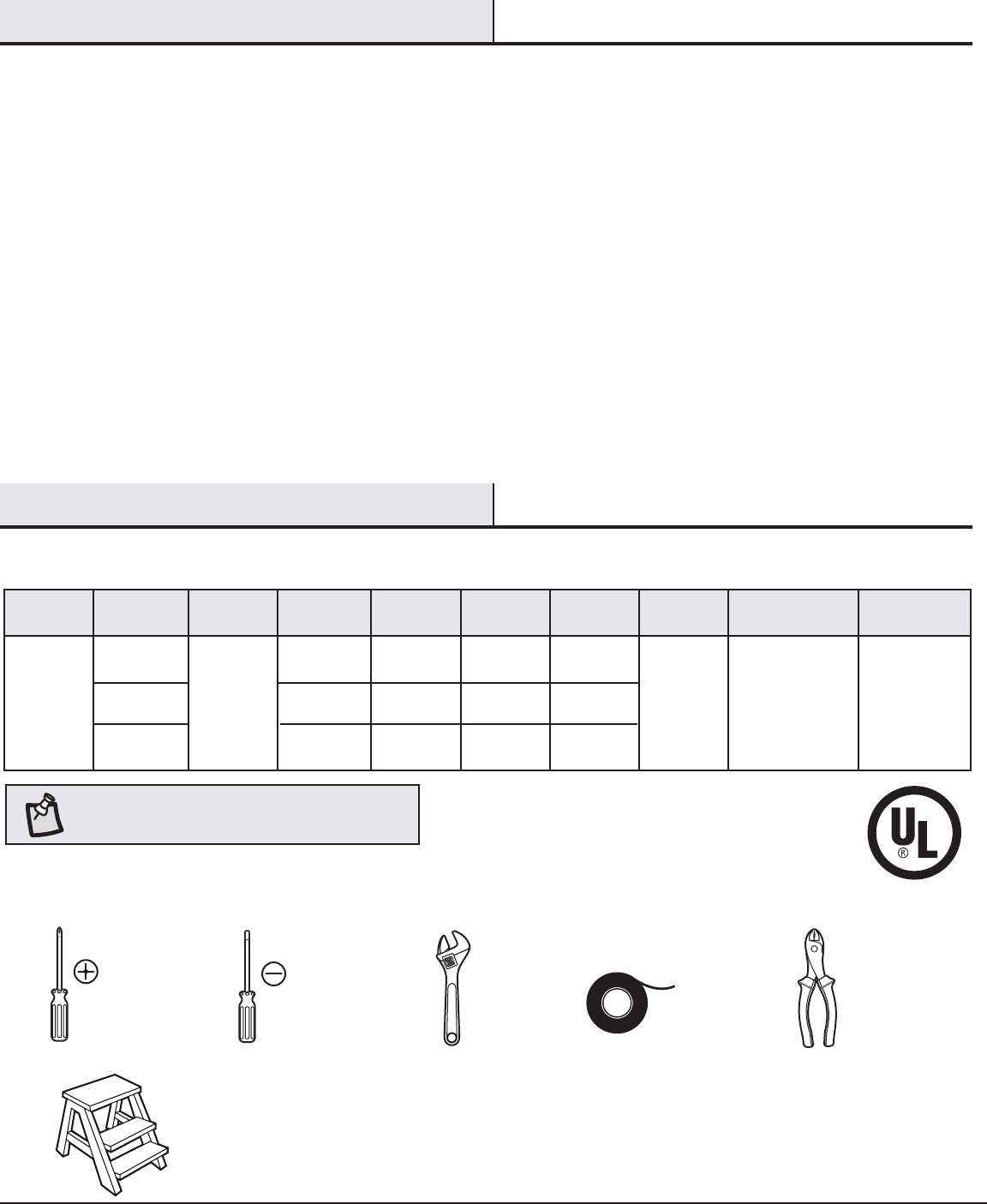
3HAMPTONBAY.COM
Para obtener asistencia, llama al 1-877-527-0313.
Preinstalación
Garantía
A partir de la fecha de compra por el comprador original, el proveedor garantiza de por vida, que el motor del ventilador no presenta defectos de
fabricación ni de material desde la fecha de salida de la fábrica. El proveedor también garantiza por un período de un año, a partir de la fecha de
compra por el comprador original, que todas las demás piezas del ventilador, sin incluir ningún aspa de vidrio o acrílico, no presentarán ningún
defecto de fabricación o de material en el momento de su salida de la fábrica. Acordamos reparar todos los defectos del tipo antes mencionado,
sin cargo alguno, o a nuestra discreción, reemplazar el producto por un modelo de calidad comparable o superior si el producto se devuelve. Para
obtener servicio de garantía usted debe presentar una copia del recibo como comprobante de compra. Todos los costos de retiro y reinstalación
del producto son su responsabilidad. Daños a cualquiera de las piezas como resultado de accidentes, instalación o uso incorrecto o debidos a la
instalación de cualquier accesorio, no están cubiertos bajo esta garantía. Debido a que las condiciones climáticas pueden variar, esta garantía
no cubre ningún cambio del acabado en bronce, incluyendo óxido, perforación, corrosión, manchas o descascaramiento. Los acabados en bronce
de este tipo tienen una vida útil más prolongada cuando se protegen de las condiciones climáticas cambiantes. Es normal cierta “oscilación”
y no debe ser considerado como un defecto. Cualquier servicio técnico conducido por personas no autorizadas anulará la garantía. No hay
ninguna otra garantía expresa. Mediante la presente Hampton Bay se exime de cualquier garantía, incluyendo pero sin limitarse a aquellas de
comercialización e idoneidad para un n particular, de acuerdo a lo contemplado por la ley. La duración de cualquier garantía implícita que
no se pueda eximir, está limitada al período de tiempo especicado en la garantía explícita. Algunos estados no permiten una limitación en la
duración de la garantía, por consiguiente la limitación anterior puede no aplicarse a su caso. El minorista no será responsable por daños directos,
indirectos o especiales que resulten o deriven del uso o rendimiento del producto excepto en casos en que lo estipule la ley. Algunos estados no
permiten la exclusión o limitación de daños directos o indirectos, por lo que la limitación o exclusión anterior podría no aplicarse a su caso. Esta
garantía le otorga derechos legales especícos pero es posible que también tenga otros derechos que varían de un estado a otro. Esta garantía
sustituye todas las garantías anteriores. Los costos de envío de cualquier devolución de productos hecha como parte de una reclamación de
garantía deben ser pagados por el cliente.
Comuníquese con el Equipo de Servicio al Cliente llamando al 1-877-527-0313 o visite www.HamptonBay.com.
ESPECIFICACIONES
HERRAMIENTAS NECESARIAS
NOTA: Estas medidas son aproximadas. No incluyen ni
el amperaje ni el vataje consumido por el kit de luces.
Destornillador
Phillips
Destornillador
plano
Llave
ajustable
Cinta de
electricista Cortacables
Escalera
Tamaño Velocidad Voltios Amperios Watts RPM PCM Peso
Neto
Peso
Bruto
Pies
cúbicos
52 plg
(1,32 m)
Baja
Media
Alta
120
0,33
0,45
0,56
13,6
30,1
65,2
70
110
165
2613
4030
5924
22,49 lb
(10,2 kg)
26,24 lb
(11,9 kg) 2,3’
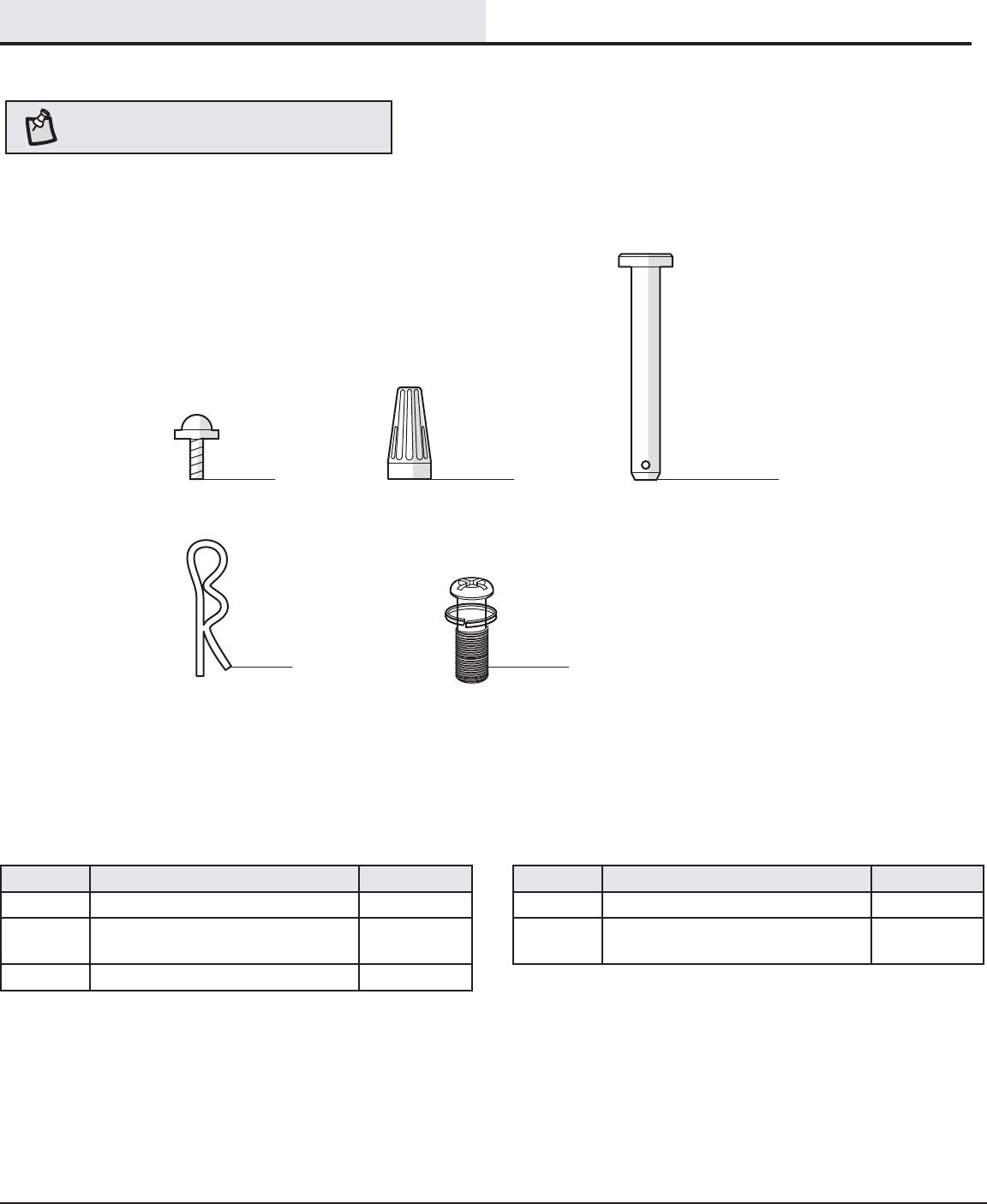
4
Pieza Descripción Cantidad
AA Tornillos para el montaje de aspas 16
BB Tuerca de plástico para conectar
cables 3
CC Pasador de soporte 1
Pieza Descripción Cantidad
DD Pasador de cierre 1
EE Tornillo adicional para soporte de
aspas con contratuerca 11
t
Preinstalación (continuación)
HERRAJES INCLUIDOS
NOTA: No se muestra el tamaño real de los herrajes.
AA BB CC
EE
DD
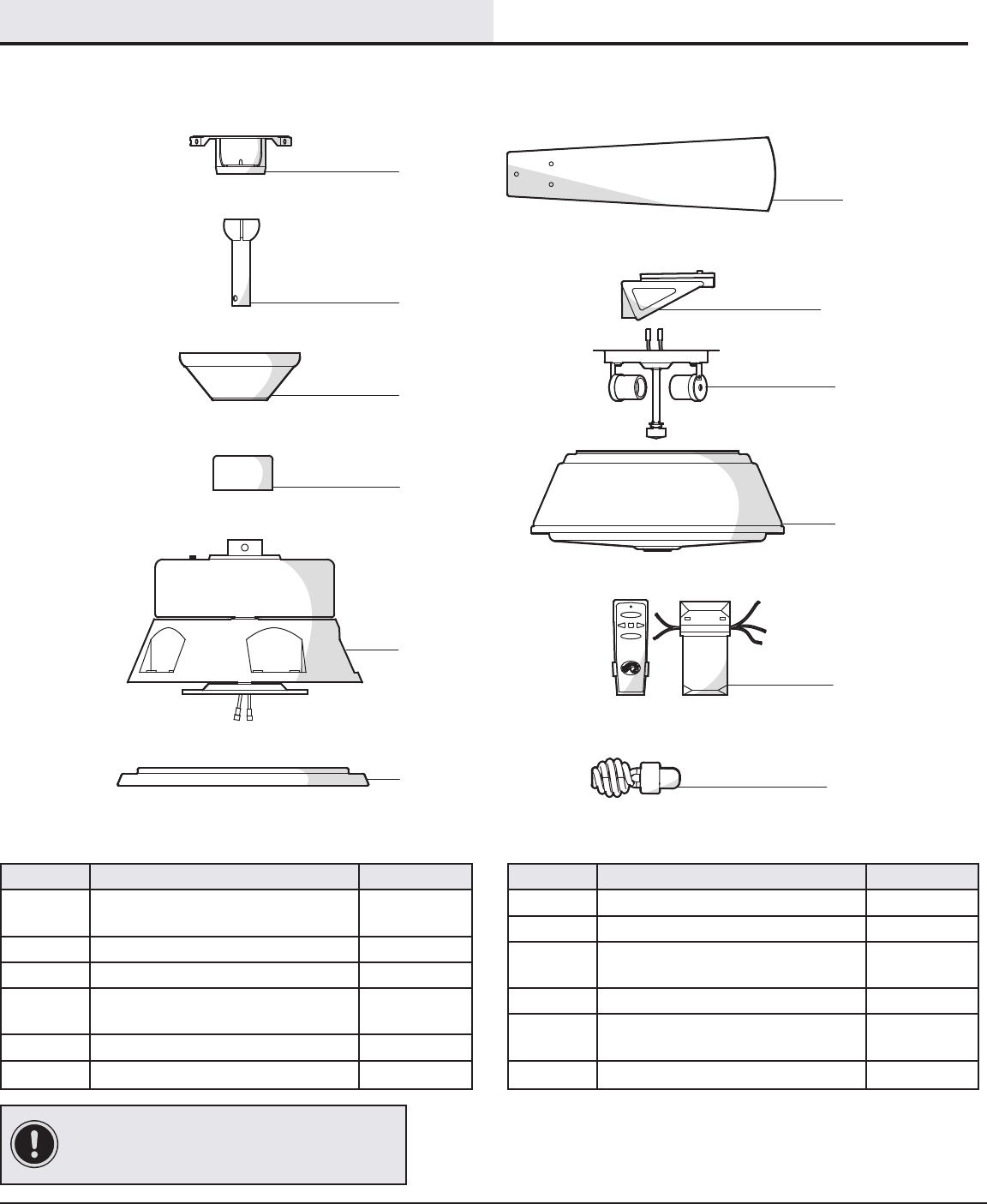
5HAMPTONBAY.COM
Para obtener asistencia, llama al 1-877-527-0313.
Pieza Descripción Cantidad
ASoporte de montaje deslizante
(dentro de la cubierta) 1
B Ensamblaje de tubo bajante/bola 1
C Cubierta con aro incorporado 1
D Cubierta decorativa del collarín del
motor
1
E Ensamblaje del motor del ventilador 1
F Carcasa del kit de luces 1
Pieza Descripción Cantidad
G Aspa 5
H Soporte de aspa 5
IEnsamblaje del soporte del kit de
luces 1
J Tazón de vidrio 1
KControl remoto/receptor
(baterías incluidas) 1
L Bombilla CFL, máximo de 14 W 2
IMPORTANTE: Este producto y/o sus componentes están
protegidos por una o más de las siguientes Patentes de
los EE. UU.: 5,947,436; 5,988,580; 6,010,110; 6,046,416,
6,210,117 y otras patentes pendientes.
Preinstalación (continuación)
CONTENIDO DEL PAQUETE
BB
A
B
C
D
E
I
H
F
K
J
G
L
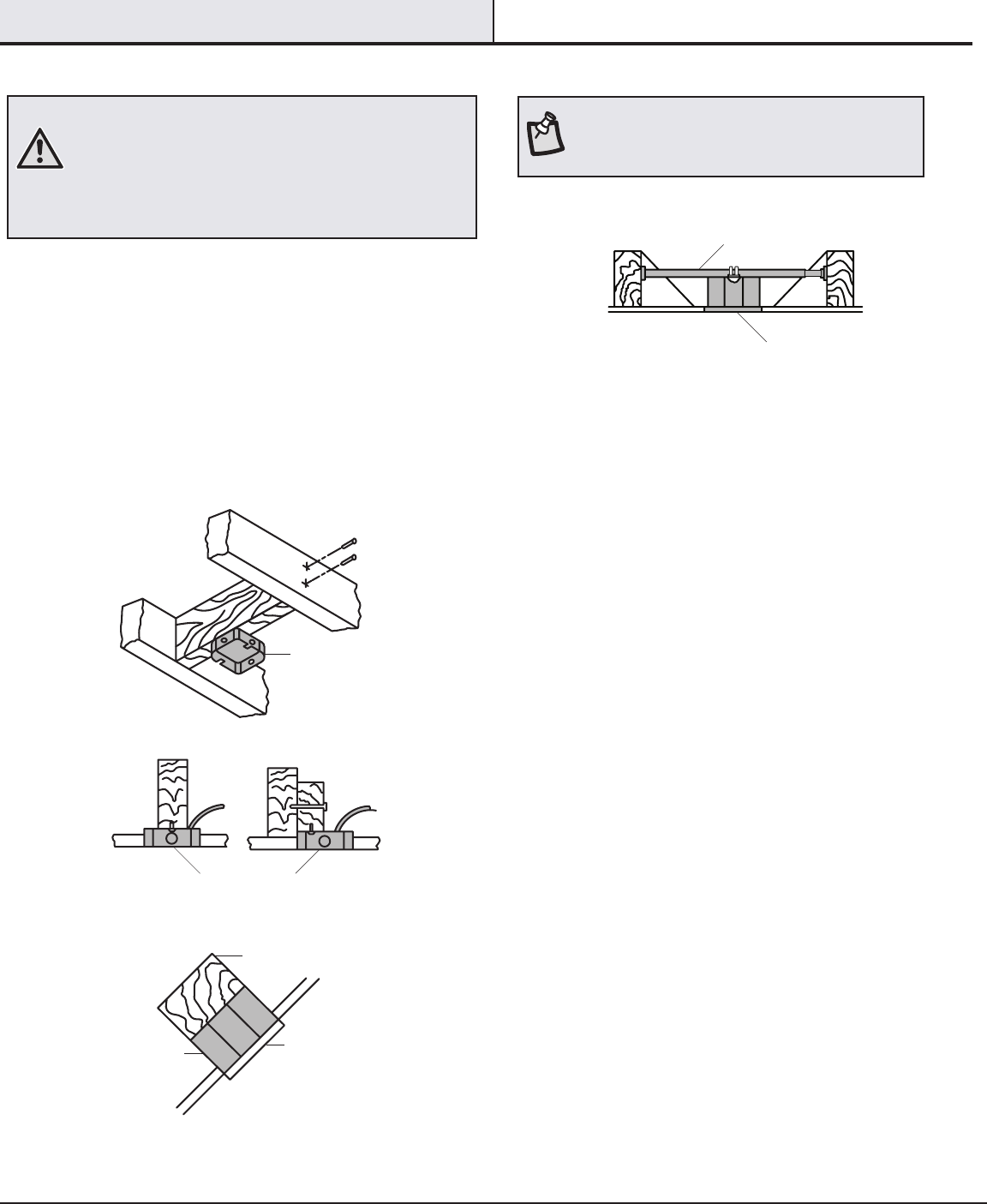
6
Instalación
OPCIONES DE MONTAJE
ADVERTENCIA: Para reducir el riesgo de incendio, descarga eléctrica
o lesiones personales, monta el ventilador sobre una caja eléctrica
marcada como “aprobada como soporte de ventiladores de 35 lb (15,9
kg) o menos”, y usa los tornillos de montaje que vienen con la misma.
Las cajas eléctricas utilizadas comúnmente para el soporte de artículos
de iluminación pueden no servir como soporte de ventilador, y tal
vez deban reemplazarse. En caso de duda, consulta a un electricista
calicado.
Si tu ventilador de techo no tiene una caja de montaje aprobada por
UL, instala una siguiendo las instrucciones a continuación:
□Desconecta la energía retirando los fusibles o apagando los
cortacircuitos.
□Asegura la caja eléctrica directamente a la estructura del
edicio. Usa sujetadores y materiales apropiados. La caja
eléctrica y su soporte deben poder sostener el peso completo
del ventilador en movimiento (al menos 35 lb). No uses una
caja eléctrica de plástico.
Las ilustraciones a continuación muestran tres formas distintas de
montar la caja eléctrica.
Si la cubierta (C) toca el ensamblaje del tubo bajante/bola (B), retira la
tapa inferior decorativa de la cubierta y gira la cubierta (C) 180º antes
de jarla a la placa de montaje.
Para colgar el ventilador donde ya haya una lámpara pero ninguna
viga de techo, tal vez necesites una barra colgante como se mostró
anteriormente
(disponible en cualquier tienda de The Home Depot).
NOTA: Tal vez necesites un tubo bajante más largo para
mantener la altura mínima adecuada de las aspas, al
instalar el ventilador en un techo inclinado. El ángulo
máximo permitido es de 28º de la posición horizontal.
Caja
Eléctrica
Caja Eléctrica
Caja
Eléctrica
Empotrada
Soporte Fuerte
Placa
de Montaje
en Techo
Caja Eléctrica
Barra para Colgar
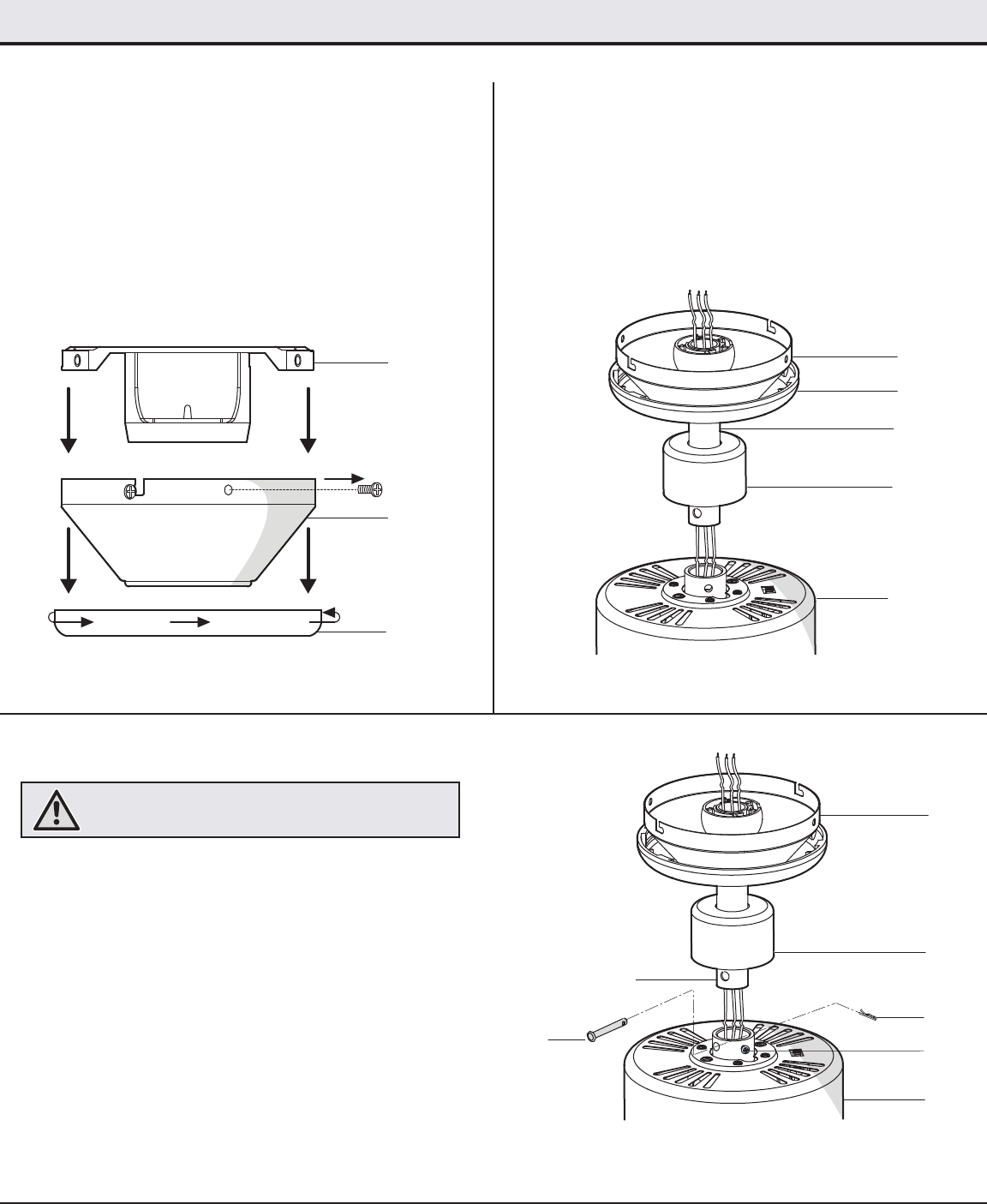
7HAMPTONBAY.COM
Para obtener asistencia, llama al 1-877-527-0313.
Ensamblaje – Montaje Estándar en Techo
Disposición de los cables
Cómo ensamblar el ventilador
Preparación para el montaje
□Aoja, sin quitar, los tornillos (HH) del collarín ubicados en la
parte superior del ensamblaje del motor del ventilador (E).
□Alinea los oricios en la parte inferior del ensamblaje del tubo
bajante/bola (B) con los oricios en el collarín de la parte
superior del ensamblaje del motor del ventilador (E).
□Inserta con cuidado el pasador de soporte (CC) a través de los
oricios del collarín y del ensamblaje del tubo bajante/bola
(B). Ten cuidado de no forzar el pasador de soporte (CC) contra
el cableado dentro del ensamblaje del tubo bajante/bola (B).
□Inserta el pasador de cierre (DD) en el oricio cercano al
extremo del pasador de sujeción (CC) hasta que quede
encajado en su posición.
□Vuelve a apretar los tornillos (HH) del collarín ubicados en la
parte superior del ensamblaje del motor del ventilador (E).
□Retira el aro (O) de la cubierta (C), girándolo hacia la derecha
hasta soltarlo.
□Retira el soporte de montaje (A) de la cubierta (C) aojando los
cuatro tornillos en la parte superior de la cubierta (C).
□Quita los dos tornillos sin ranura y aoja los tornillos
ranurados. Esto te permitirá retirar el soporte de montaje (A).
□Inserta los cables que salen por la parte superior del
motor del ventilador (E) en la cubierta decorativa del
collarín del motor (D) y a través del aro de la cubierta (O).
□Asegúrate de que las aberturas en forma de ranura estén
en la parte superior y, primero, inserta los cables por
la cubierta (C), y luego a través del ensamblaje de tubo
bajante/bola (B).
2
3
1
C
A
O
E
D
C
B
O
B
CC
DD
D
E
C
B
HH
ADVERTENCIA: Si no instalas correctamente el pasador de
cierre es posible que el ventilador se aoje y se caiga.
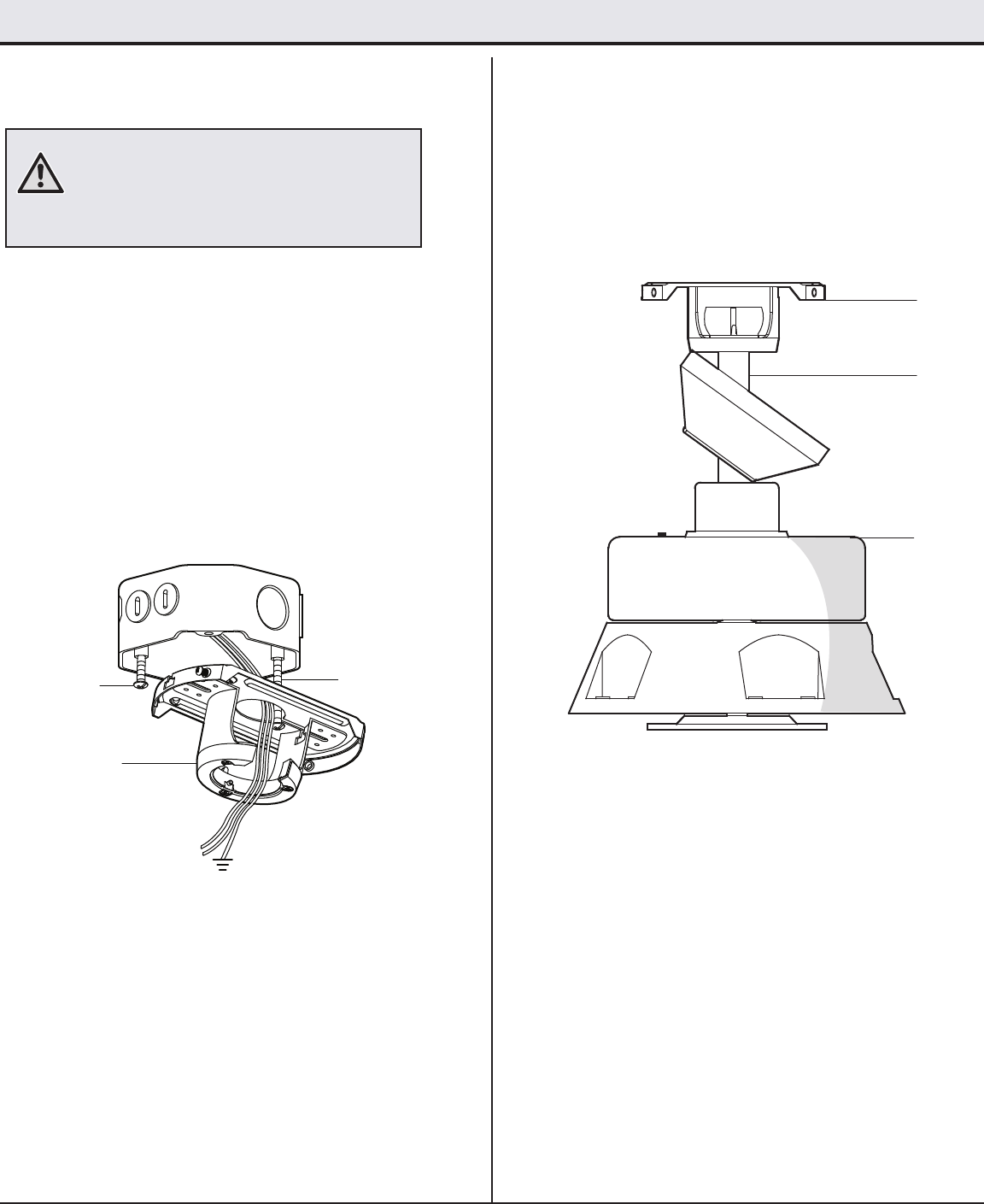
8
Ensamblaje – Cómo Colgar el Ventilador
Cómo jar el ventilador
a la caja eléctrica
Cómo colgar el ventilador
□Pasa los cables de suministro de 120 Voltios a través del
oricio central en el soporte de montaje deslizante (A).
□Instala el soporte de montaje de techo sobre la caja
eléctrica deslizando el soporte de montaje (A) sobre los
dos tornillos (UU) suministrados con la caja eléctrica. Si
es necesario, usa arandelas niveladoras (no incluidas)
entre el soporte de montaje deslizante (A) y la caja
eléctrica. Fíjate que el lado plano del soporte de
montaje (A) esté hacia la caja eléctrica.
□Ajusta rmemente los dos tornillos de montaje (UU).
□Con cuidado alza el ensamblaje del motor del ventilador (E)
hasta el soporte de montaje deslizante (A).
□Coloca la bola de soporte del ensamblaje del tubo bajante/bola
(B) en el soporte de montaje. Asegúrate de que la pestaña sobre
el soporte de montaje deslizante (A) encaje bien dentro de la
ranura de la bola de soporte.
4 5
ADVERTENCIA: Para reducir el riesgo de incendio,
descarga eléctrica o lesiones personales, monta el
ventilador sobre una caja eléctrica marcada como
“aprobada como soporte de ventiladores de 35 lb (15,9
kg) o menos”, y usa los tornillos de montaje que vienen
con la caja eléctrica.
A
UU UU
A
B
E
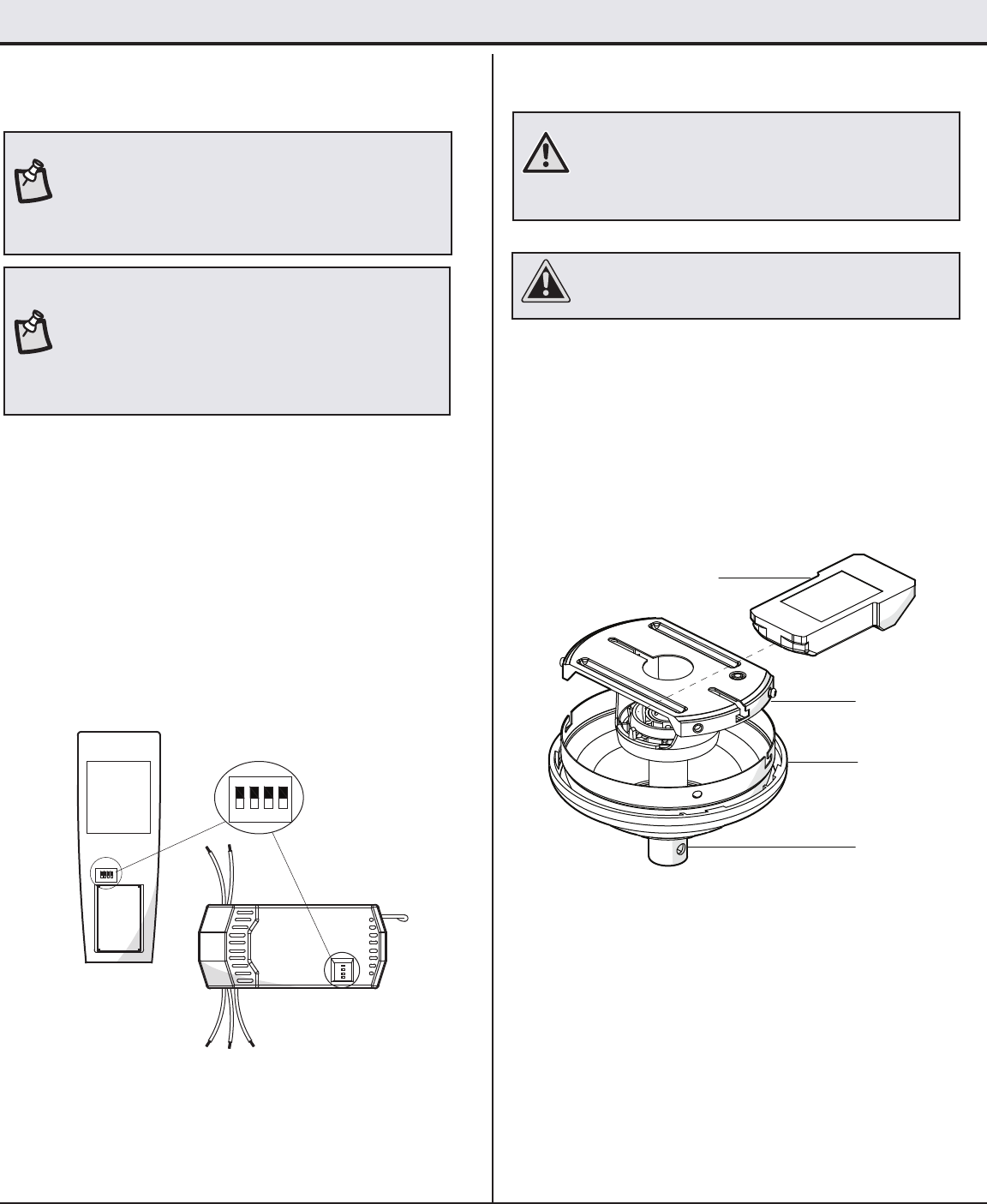
9HAMPTONBAY.COM
Para obtener asistencia, llama al 1-877-527-0313.
Ensamblaje – Cómo Colgar el Ventilador (continuación)
1 2 3
ON
4
1 2 3
ON
4
DIP
Cómo congurar los códigos
del control remoto
6
NOTA: Las frecuencias del receptor y control remoto han sido
preconguradas en la fábrica. Antes de instalar el receptor,
asegúrate de que los interruptores en el transmisor y del
control remoto estén congurados en la misma frecuencia. Los
interruptores en el transmisor del control remoto están ubicados
dentro del compartimento de la batería.
Para congurar el código del control remoto:
□Quita la cubierta de la batería presionando con rmeza en la
echa y deslizando la cubierta hasta soltarla.
□Desliza los interruptores de código según tu elección hacia
arriba o hacia abajo. Las conguraciones de fábrica son
hacia arriba.
□Instala una batería de 9 V (incluida) en el control remoto.
□Coloca de nuevo la cubierta en el control remoto.
Para congurar el código del receptor:
□Desliza los interruptores de código hacia la misma posición
que elegiste para el control remoto.
Modelo del Controlador: FAN28R-240W
NOTA: Este control remoto está equipado con 16
combinaciones de códigos. Para evitar posibles interferencias
desde o hacia otras unidades de control remoto como los
abrepuertas de garajes, alarmas de autos o sistemas de
seguridad, cambia el código de combinación pero asegúrate
de que el código del transmisor de mano y el del receptor del
ventilador sean iguales.
Cómo instalar el receptor
□Posiciona el control remoto/receptor (K) con el lado plano
hacia arriba y perpendicular al soporte de montaje (A).
□Ubica los cables de suministro en el lado izquierdo del soporte
de montaje deslizante (A), y coloca los cables del ventilador en
el lado derecho.
□Inserta parcialmente el receptor del control remoto (K) con el
lado plano hacia arriba, hasta que un extremo descanse sobre
el ensamblaje del tubo bajante/bola (B).
7
ADVERTENCIA: Para reducir el riesgo de incendio o de descarga
eléctrica, recuerda desconectar la electricidad. El cableado
eléctrico debe cumplir todos los requisitos del código nacional
de electricidad y los códigos locales de electricidad. Las fuentes
de energía y el ventilador deben ser de 110/120 V y 60 Hz.
PRECAUCIÓN: Si otros cables del ventilador son de color
diferente, un electricista certicado deberá instalar esta unidad.
A
B
K
C
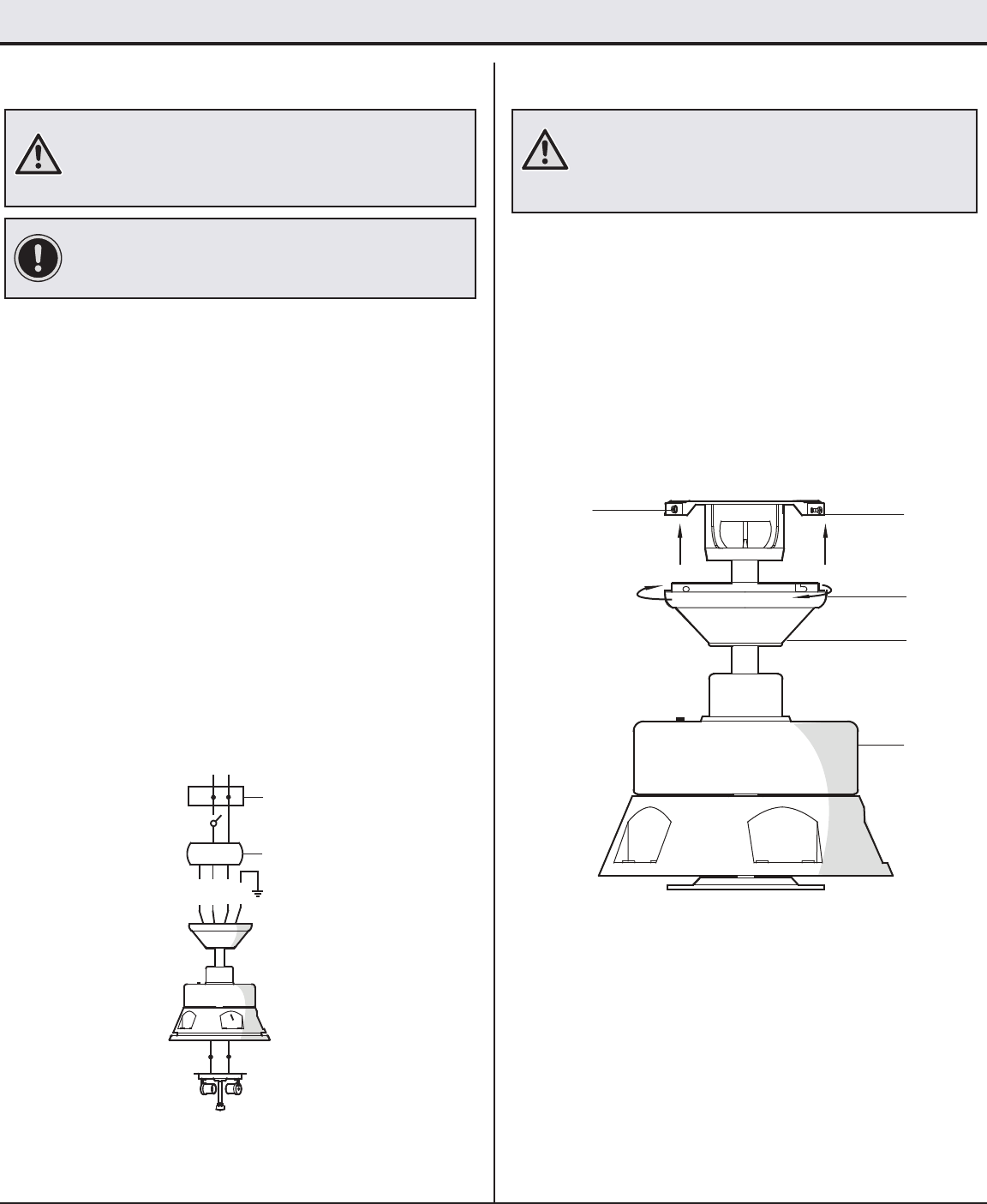
10
Cómo montar el ventilador
□Alinea las ranuras de cierre de la cubierta (C) con los dos
tornillos del soporte deslizante de montaje (A). Alza para
enganchar las ranuras y gira de izquierda a derecha para
asegurar la cubierta (C) en su sitio.
□Ajusta rmemente los dos tornillos de montaje (M).
□Instala los dos tornillos de montaje restantes (M) en los
oricios de la cubierta (C) y aprieta rmemente.
□Instala el aro de cubierta (O) alineando las ranuras del aro con
los tornillos en la cubierta (C). Rota el aro en sentido contrario
a las manecillas del reloj para jarlo.
9
ADVERTENCIA: Cuando uses el ensamblaje del tubo bajante/
bola estándar, la pestaña en el aro en la parte inferior del soporte
de montaje debe encajar en la ranura de la bola de soporte. Si
la pestaña no se asienta correctamente en la ranura, se puede
dañar el cableado.
LL
LL
KK
JJ
II
MM
NN
OO
LL
LL
KK
JJ
KK
LL
A
C
M
E
O
Ensamblaje – Cómo Colgar el Ventilador (continuación)
Cómo hacer las conexiones eléctricas
□Conecta el conductor a tierra del cable de 120 Voltios (puede ser
un cable desnudo o un cable con aislante verde) al (los) cable(s)
terminal(es) a tierra verde(s) (II) del ventilador usando una tuerca de
plástico para conexión de cables (BB).
□Conecta el cable blanco del motor del ventilador (LL) al cable blanco
(LL) del receptor (NN) usando un conector de cables plástico (BB).
□Conecta el cable negro del motor del ventilador (KK) al cable negro
(KK) del receptor (NN) usando un conector de cables plástico (BB).
□Conecta el cable azul del motor del ventilador (JJ) al cable azul (JJ)
del receptor (NN) usando un conector de cables plástico (BB).
□Conecta el cable rojo (OO) del receptor (NN) al cable negro
(positivo) de suministro de energía (KK) usando un conector
de cables plástico (BB).
□Conecta el cable blanco (LL) del receptor (NN) al cable blanco (neutro)
(LL) de suministro usando un conector de cables plástico (BB).
□Después de conectar los cables, sepáralos de manera que los cables
verde (II) y blanco (LL) queden de un lado de la caja eléctrica (MM) y
el cable negro (KK) del otro lado.
□Gira las tuercas de conexión del cable hacia arriba y con cuidado
coloca el cableado dentro de la caja eléctrica (MM).
8
IMPORTANTE: Usa las tuercas de plástico para conectar cables
(BB) incluidas con tu ventilador y el control remoto. Amarra los
conectores con cinta eléctrica y asegúrate de que no haya cables
o conexiones sueltas.
ADVERTENCIA: Cada cable no suministrado con este ventilador está
diseñado para aceptar hasta un circuito eléctrico de casa de calibre
12 y dos cables del ventilador. Si tienes un cableado superior a calibre
12 o más de un cable para conectar al ventilador, consulta a un
electricista para conocer el tamaño adecuado de las tuercas a usar.
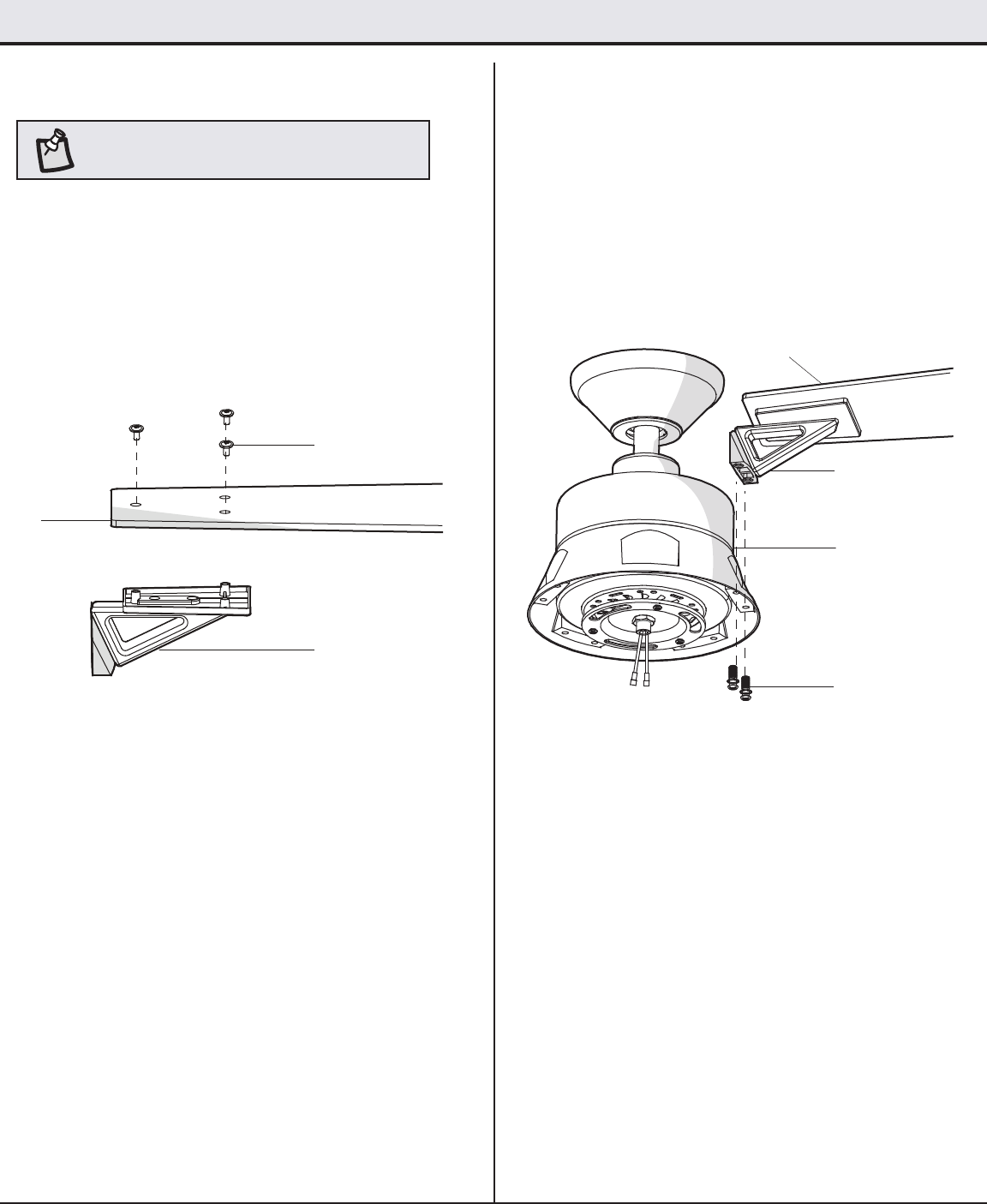
11 HAMPTONBAY.COM
Para obtener asistencia, llama al 1-877-527-0313.
Ensamblaje – Cómo Unir las Aspas del Ventilador
Cómo unir las aspas del ventilador Cómo montar las aspas
ensambladas
10 11
□Monta el aspa (G) al soporte de la misma (H) usando los
tornillos para montar las aspas (AA). Monta un tornillo
para montar las aspas (AA) en el soporte del aspa (H).
Repite el proceso para los dos tornillos de montaje de
aspas (AA) restantes.
□Aprieta cada tornillo para montar las aspas (AA) de
forma segura.
□Coloca el aspa en la carcasa del motor del ventilador (E)
alineando los dos oricios del soporte del aspa (H) con los dos
oricios del ensamblaje del motor del ventilador (E).
□Inserta el tornillo para soporte (EE) en el soporte del aspa (H).
Repite el paso con el otro tornillo.
□Aprieta cada tornillo del soporte (EE) de forma segura.
□Repite estos pasos para las aspas restantes (G).
AA
G
H
H
G
E
EE
NOTA:Las aspas de tu ventilador son reversibles. Elige
el acabado del aspa que mejor resalte tu decoración.
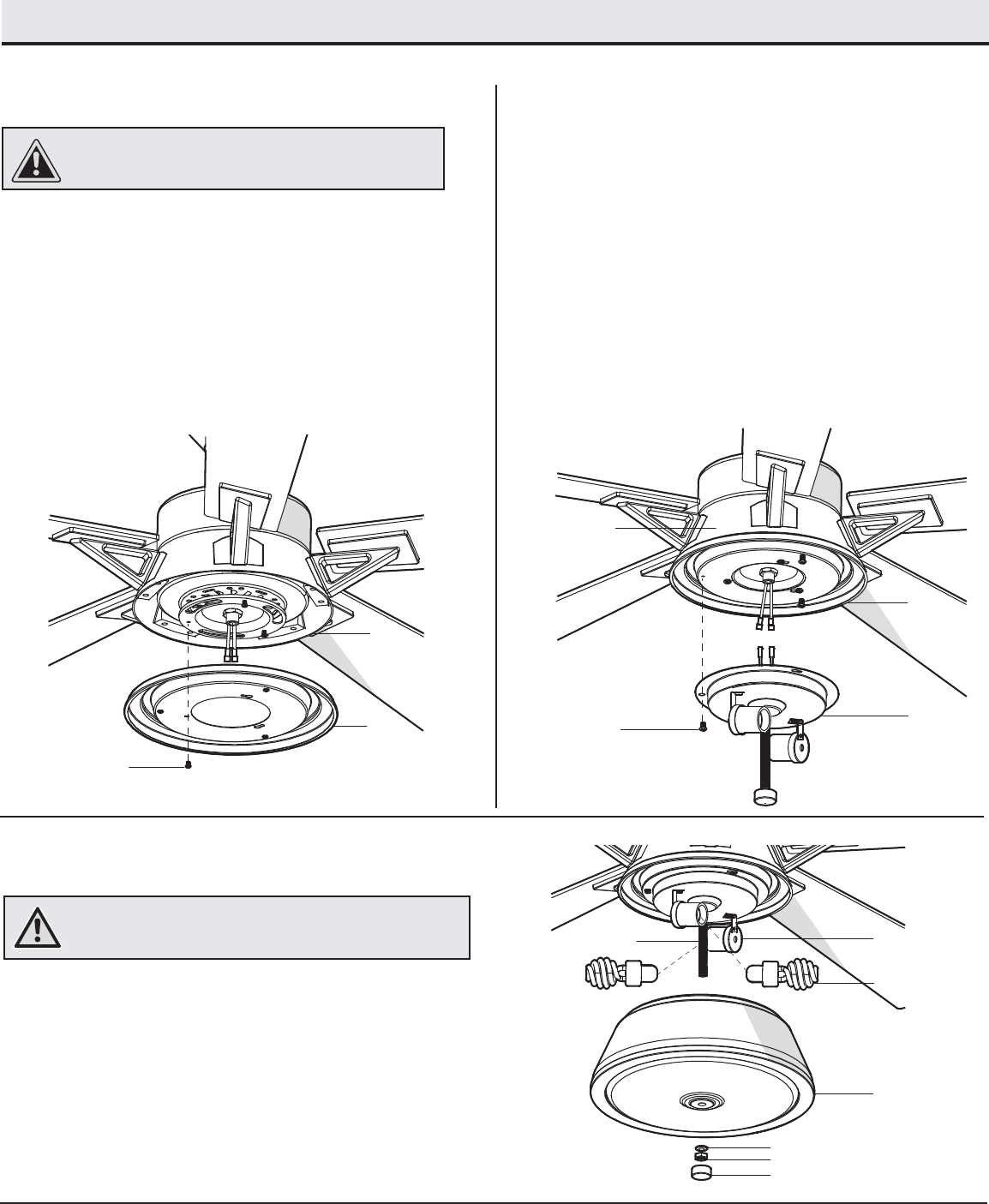
12
Ensamblaje – Cómo Instalar el Kit de Luces
Cómo instalar la carcasa
del kit de luces
Cómo instalar el kit de luces
Cómo instalar las bombillas y
el tazón de vidrio
12 13
14
□Quita un tornillo (N) del soporte negro debajo del
ensamblaje del motor del ventilador (E). Aoja los otros
dos tornillos, sin quitarlos.
□Monta la carcasa del kit de luces (F) en el ensamblaje
del motor del ventilador (E) y fíjala con los dos tornillos
(N) aojados en el primer paso. Empuja la carcasa del kit
de luces (F) hasta enganchar las cabezas de los tornillos
en las ranuras y gírala para jarla. Vuelve a instalar
el tornillo (N) que retiraste en el primer paso. Aprieta
rmemente todos los tornillos.
□Quita un tornillo (P) de la carcasa del kit de luces (F). Aoja los
otros dos tornillos, sin quitarlos.
□Conecta el cable azul que sobresale por debajo del ensamblaje del
motor del ventilador (E) con el cable negro de la parte superior del
ensamblaje del soporte del kit de luces (I).
□Conecta el cable blanco que sobresale por debajo del ensamblaje
del motor del ventilador (E) con el cable blanco de la parte
superior del ensamblaje del soporte del kit de luces (I).
□Monta el soporte del kit de luces (I) en la carcasa del kit de
luces (F) y fíjalo con los dos tornillos (P) aojados en el primer
paso. Empuja el ensamblaje del soporte del kit de luces (I) hasta
enganchar las cabezas de los tornillos en las ranuras y gíralo para
jarlo. Vuelve a instalar el tornillo (P) que retiraste en el primer
paso. Aprieta rmemente todos los tornillos.
□Con la electricidad apagada, instala las bombillas (L)
(de 14 W máximo, incluidas) enroscándolas en los
portabombillas.
□Retira el remate (PP), la tuerca hexagonal (QQ) y la
arandela de goma (RR) de la boquilla roscada (SS) del
ensamblaje del soporte del kit de luces (I). Coloca la
boquilla roscada a través del oricio central del tazón
de vidrio (J). Vuelve a colocar la arandela de goma
(RR), la tuerca hexagonal (QQ) y el remate (PP).
PRECAUCIÓN: Para disminuir el riesgo de descarga eléctrica,
desconecta el circuito de energía del ventilador antes de
instalar el kit de luces.
ADVERTENCIA: No aprietes demasiado al instalar la pantalla de
vidrio en el ensamblaje del kit de luces. Espera que la pantalla de
vidrio se enfríe completamente antes de retirarla.
E
F
N
F
I
P
E
J
PP
QQ
RR
SS
L
I
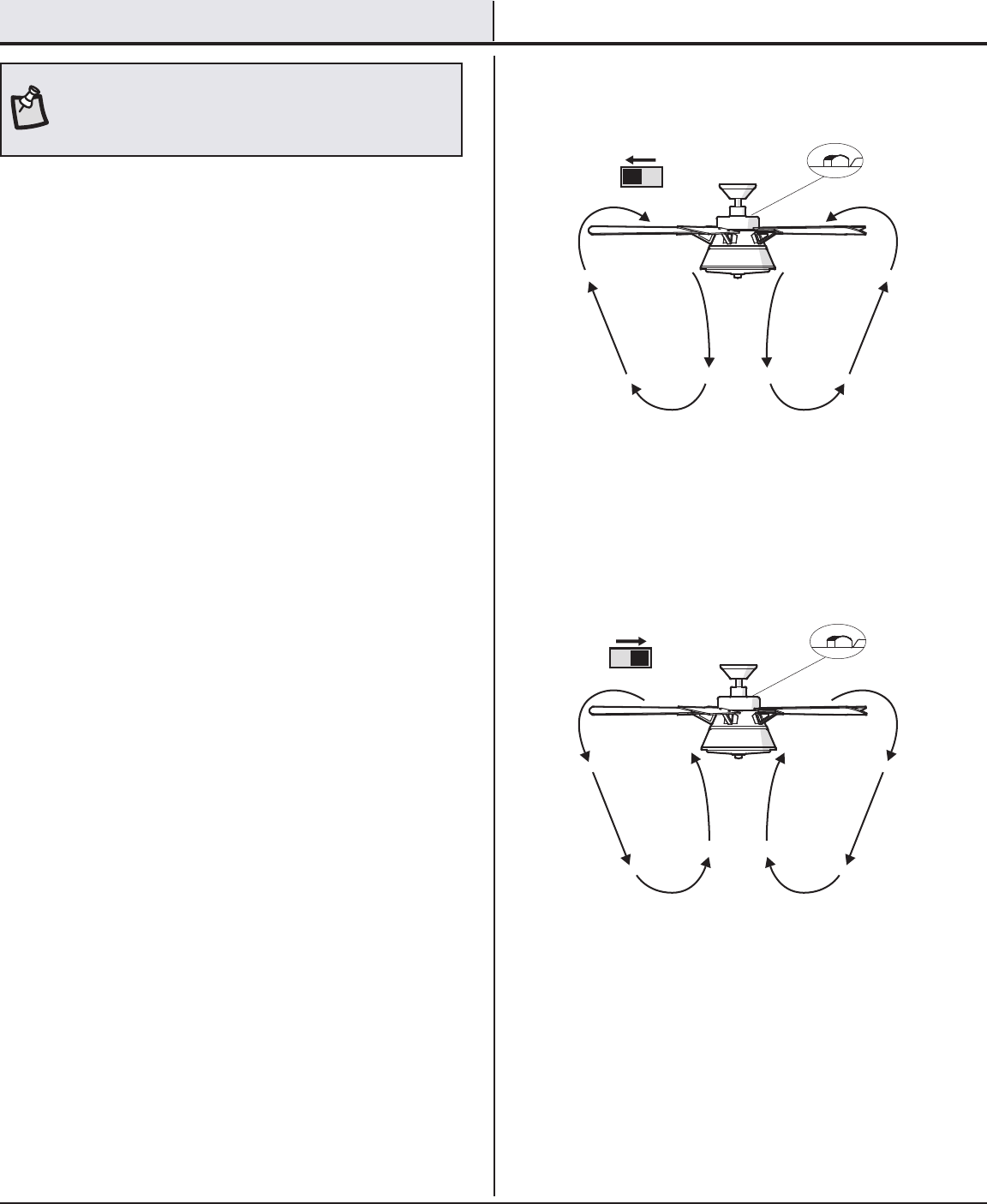
13 HAMPTONBAY.COM
Para obtener asistencia, llama al 1-877-527-0313.
Funcionamiento
Control Remoto - Tu ventilador está equipado con un control remoto
que controla la velocidad y las luces de tu ventilador de techo.
Las conguraciones de velocidad para clima cálido o frío dependen
de factores como tamaño de la habitación, altura del techo y cantidad
de ventiladores.
Este ventilador se envía desde la fábrica con el interruptor de reversa
posicionado para hacer circular el aire hacia abajo. Si deseas dirigir
la corriente de aire en la dirección contraria, apaga el ventilador y
espera que las aspas se detengan. Desliza el interruptor de reversa
(ubicado en la caja de interruptores) hacia la dirección opuesta y
luego vuelve a prender el ventilador. Las aspas del ventilador girarán
en sentido contrario y revertirán la dirección de la corriente de aire.
1. Velocidad - El control remoto tiene teclas de Bajo, Medio, Alto y
Apagado para seleccionar la velocidad de funcionamiento deseada y
para apagar o encender el ventilador.
2. Luces - Para controlar el kit de luces, el control remoto tiene un
botón de Encendido y Apagado de las luces.
Cómo poner en funcionamiento el ventilador
Botón alto = Velocidad alta
Botón medio = Velocidad media
Botón bajo = Velocidad baja
Botón de apagado = Se apaga
Encendido/apagado de las Luces = Enciende o apaga la luz
Clima frío - (Reversa) Un ujo de aire hacia arriba mueve el aire cálido
lejos del techo. Esto te permite congurar la unidad de calefacción más
baja sin afectar tu comodidad.
Clima cálido - (Hacia adelante) Un ujo de aire descendente crea un
efecto de enfriamiento. Esto te permite jar tu aire acondicionado en
una conguración más alta sin afectar tu comodidad.
NOTA: El interruptor de reversa está ubicado en la supercie de
la carcasa del motor. Apaga el ventilador y espera hasta que las
aspas se hayan detenido completamente antes de presionar el
interruptor para invertir la dirección de tu ventilador de techo.
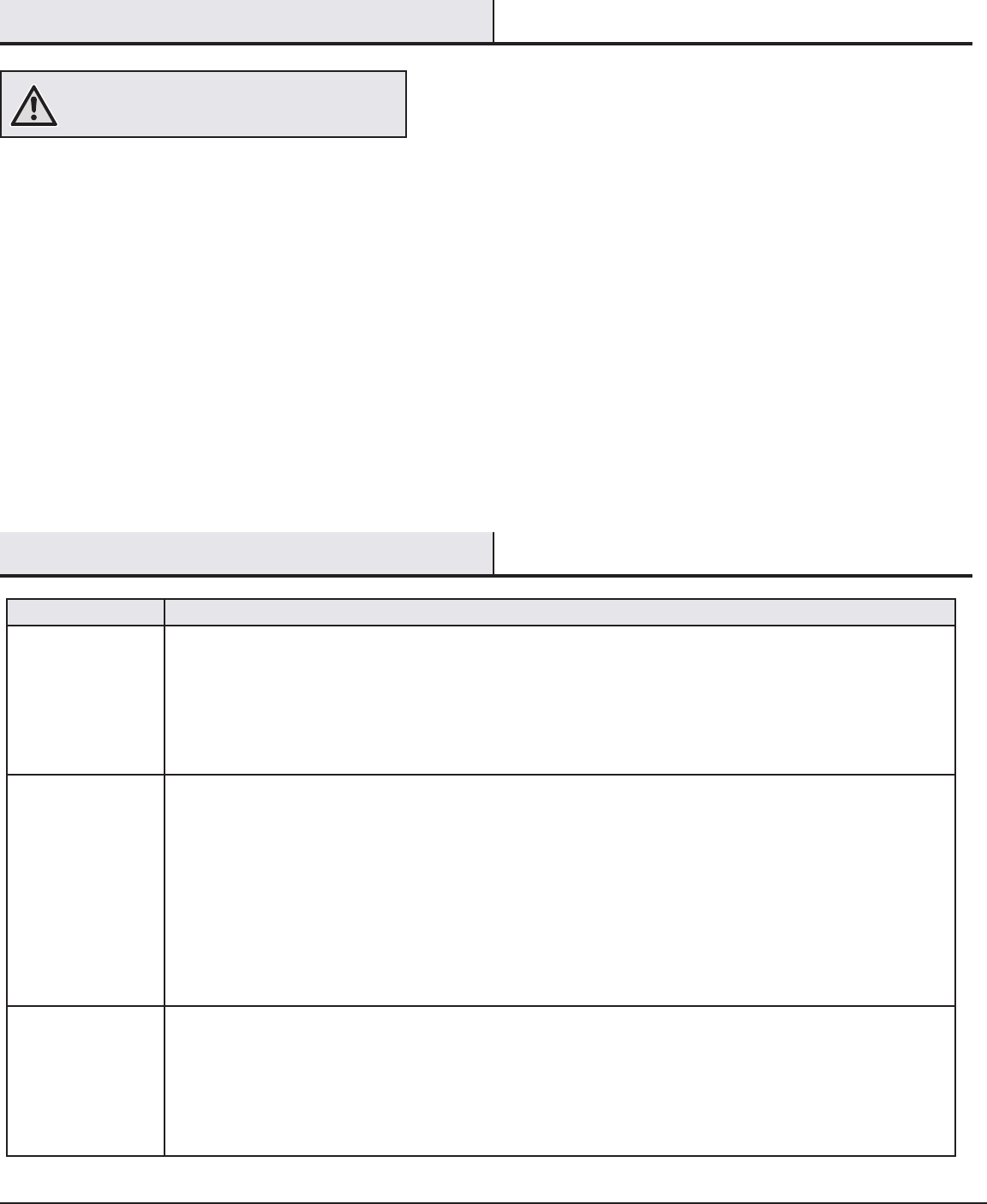
14
Solución de problemas
Problema Solución
El ventilador no
enciende.
□Verica los fusibles o disyuntores principales y secundarios.
□Verica las conexiones de cables en línea al ventilador y conexiones de cables del interruptor en la caja de
interruptores.
□Revisa la batería del control remoto.
□Asegúrate de estar en el rango normal de 10 a 20 pies.
□Apaga la electricidad y asegúrate de que coincidan las conguraciones del interruptor en el control remoto y el
receptor.
El ventilador hace
ruido.
□Asegúrate de que los tornillos de la carcasa del motor estén ajustados.
□Asegúrate de que los tornillos que unen el soporte del aspa al cuerpo del motor están bien ajustados.
□Asegúrate de que las conexiones de tuerca de cable no choquen unas con otras o con la pared interior de la caja
del interruptor.
□Permite un período de 24 horas de “adaptación”. La mayoría de los ruidos asociados con un nuevo ventilador
desaparecen en ese período.
□Si usas el kit de luces de ventilador de techo, asegúrate de que los tornillos que sujetan el vidrio estén bien
colocados. Verica que las bombillas estén bien aseguradas.
□Asegúrate de que la cubierta esté a una corta distancia del techo. No debería tocar el techo.
□Asegúrate de que tu caja eléctrica esté bien segura y las almohadillas aislantes de goma se hayan instalado
entre la placa de montaje y la caja eléctrica.
El ventilador oscila. □Verica que todas las aspas y tornillos de los brazos de aspas estén seguros.
□La mayoría de los problemas de oscilación del ventilador se deben a que las aspas no están a un mismo nivel.
Verica este nivel seleccionando un punto en el techo sobre la punta de una de las aspas. Mide desde un punto
en el centro de cada aspa al punto en el techo. Mide esta distancia. Gira el ventilador hasta que la próxima aspa
quede posicionada para medir. Repite para cada aspa. Las desviaciones de la medición deben estar dentro de
un rango de 0.3 cm. Enciende el ventilador durante diez minutos. Si el ventilador continúa oscilando, comunícate
con el servicio al cliente y te enviarán un kit de compensación de aspas, sin costo alguno.
□Debido al movimiento natural del ventilador, algunas conexiones pueden aojarse. Revisa las conexiones de soporte, soportes y accesorios
de aspas dos veces al año. Verica que estén seguros. No es necesario desmontar el ventilador del techo.
□Limpia tu ventilador con frecuencia, para que luzca como nuevo con el paso de los años. No uses agua al limpiar, esto puede dañar el
motor o la madera, o causar descargas eléctricas. Usa solamente un cepillo suave o un trapo sin pelusas para evitar arañar el acabado. El
revestimiento está sellado con laca para minimizar la decoloración u opacidad.
□Puedes aplicar a la madera una na capa de pulimento para muebles para una mayor protección y belleza. Cubre los arañazos pequeños
con una leve aplicación de lustrador para calzado.
□No necesitas lubricar tu ventilador. El motor tiene cojinetes de bola sellados, permanentemente lubricados.
ADVERTENCIA: Asegúrate de que la corriente esté
apagada antes de limpiar el ventilador.
Mantenimiento y limpieza

¿Preguntas, problemas o piezas faltantes? Antes de regresar a la tienda,
llama al Servicio al Cliente de Hampton Bay
de Lunes a Viernes entre 8 a.m. y 6 p.m., (Hora del Este de EE. UU.)
1-877-527-0313
HAMPTONBAY.COM
Conserva este manual para uso en el futuro.